-
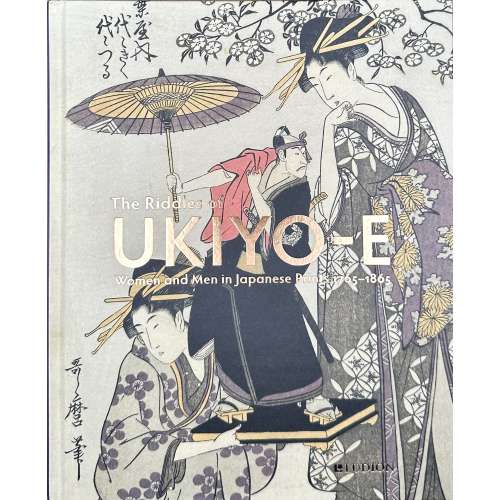 NEWHardcover volume 295 x 240 mm, pictorial front cover and purple spine with gilt embossed lettering, back cover with orange lettering, craft endpapers, pp.: [1-6] 7-255 [1], profusely illustrated. Exhibition catalogue with 123 reproductions of Japanese woodblock prints. Title-page: The Riddles of | UKIYO-E | Women and Men in Japanese Prints 1765–1865 | Chris Uhlenbeck / Jim Dwinger / Josephine Smit | {publisher’s device LUDION} || Table of contents: Preface; Introduction; Beauties; Shunga; Legends; Kabuki; INDEX; LIST OF WORKS; BIBLIOGRAPHY; AUTHORS.
NEWHardcover volume 295 x 240 mm, pictorial front cover and purple spine with gilt embossed lettering, back cover with orange lettering, craft endpapers, pp.: [1-6] 7-255 [1], profusely illustrated. Exhibition catalogue with 123 reproductions of Japanese woodblock prints. Title-page: The Riddles of | UKIYO-E | Women and Men in Japanese Prints 1765–1865 | Chris Uhlenbeck / Jim Dwinger / Josephine Smit | {publisher’s device LUDION} || Table of contents: Preface; Introduction; Beauties; Shunga; Legends; Kabuki; INDEX; LIST OF WORKS; BIBLIOGRAPHY; AUTHORS. -
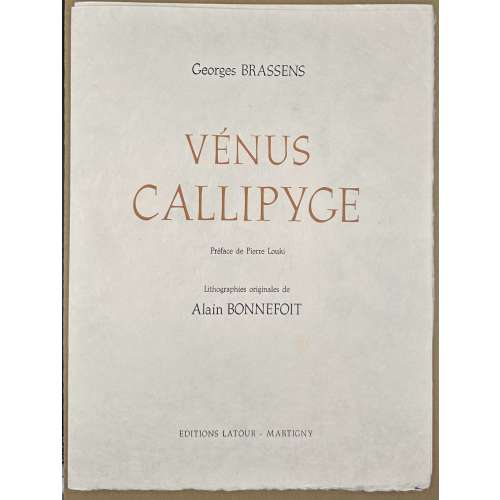 NEWUnbound, unpaginated volume in illustrated French flapped wrappers, 360 x 270 mm, printed on mother-of-pearl Japanese paper, collated 154 + 142, 60+28, 44 leaves in-folio, folded in half, profusely illustrated with original colour lithograph, in a grey cloth clamshell box (390 x 290 x 90 mm) with inside pocket for CD (lacking), embossed vignette to front; limited edition of 284 copies, signed copy № 59 of 50 copies printed on Japon Nacré paper numbered 30-80. Includes 13 double-page colour plates signed by the artist, enriched with an original watercolour drawing on the back of the title-page, with autograph dedication "A Monsieur et Madame Kuhn Amicalement A Bonnefoit". Title-page (black and sanguine): GEORGES BRASSENS | VÉNUS | CALLIPYGE | Préface de Pierre Louki | Lithographies originales de | Alain BONNEFOIT | ÉDITIONS LATOUR – MARTIGNY || Colophon : Achevé d'imprimer | le 8 novembre 1993 | sur les presses de Pierre Jean Mathan | Boulogne-sur-Seine. | Les lithographies ont été tirées | dans les ateliers de Jean-Claude Perrin | Arts-Litho à Paris. | L'emboitage est de Piero Dallai | à Forence. || Deluxe edition of a collection of 13 songs by Brassens, illustrated with more than thirty original lithographs by Alain Bonnefoit, Contributors: Alain Bonnefoit (French, b. 1937) – artist Georges Brassens (French, 1821 – 1981) – author poetry Louki, Pierre (French, 1920 – 2006) – author preface Éditions Latour (Martigny) – publisher Pierre Jean Mathan (Boulogne-sur-Seine) – printer Jean-Claude Perrin, Arts-Litho (Paris) – lithorgapher Piero Dallai (Forence) – slipcase
NEWUnbound, unpaginated volume in illustrated French flapped wrappers, 360 x 270 mm, printed on mother-of-pearl Japanese paper, collated 154 + 142, 60+28, 44 leaves in-folio, folded in half, profusely illustrated with original colour lithograph, in a grey cloth clamshell box (390 x 290 x 90 mm) with inside pocket for CD (lacking), embossed vignette to front; limited edition of 284 copies, signed copy № 59 of 50 copies printed on Japon Nacré paper numbered 30-80. Includes 13 double-page colour plates signed by the artist, enriched with an original watercolour drawing on the back of the title-page, with autograph dedication "A Monsieur et Madame Kuhn Amicalement A Bonnefoit". Title-page (black and sanguine): GEORGES BRASSENS | VÉNUS | CALLIPYGE | Préface de Pierre Louki | Lithographies originales de | Alain BONNEFOIT | ÉDITIONS LATOUR – MARTIGNY || Colophon : Achevé d'imprimer | le 8 novembre 1993 | sur les presses de Pierre Jean Mathan | Boulogne-sur-Seine. | Les lithographies ont été tirées | dans les ateliers de Jean-Claude Perrin | Arts-Litho à Paris. | L'emboitage est de Piero Dallai | à Forence. || Deluxe edition of a collection of 13 songs by Brassens, illustrated with more than thirty original lithographs by Alain Bonnefoit, Contributors: Alain Bonnefoit (French, b. 1937) – artist Georges Brassens (French, 1821 – 1981) – author poetry Louki, Pierre (French, 1920 – 2006) – author preface Éditions Latour (Martigny) – publisher Pierre Jean Mathan (Boulogne-sur-Seine) – printer Jean-Claude Perrin, Arts-Litho (Paris) – lithorgapher Piero Dallai (Forence) – slipcase -
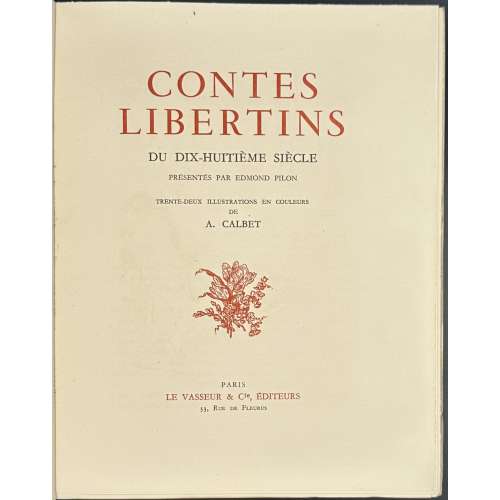 NEWSoftcover, cream French flapped wrappers, 242 x 192 mm, glassine dust jacket, lower and outer margins untrimmed, red lettering to front wrapper CONTES LIBERTINS | DU | DIX-HUITIÈME SIÈCLE; in a double slipcase; 10 full-page colour intaglio prints, incl. frontispiece, and 10 half-page coloured prints after Antoine Calbet; pp.: [1-8] 9-223 [224] [6], total 115 leaves plus ten plates with tissue guards extraneous to collation. Copy enhanced with a full suite of 32 uncoloured intaglio prints, and 12 refused plates:
NEWSoftcover, cream French flapped wrappers, 242 x 192 mm, glassine dust jacket, lower and outer margins untrimmed, red lettering to front wrapper CONTES LIBERTINS | DU | DIX-HUITIÈME SIÈCLE; in a double slipcase; 10 full-page colour intaglio prints, incl. frontispiece, and 10 half-page coloured prints after Antoine Calbet; pp.: [1-8] 9-223 [224] [6], total 115 leaves plus ten plates with tissue guards extraneous to collation. Copy enhanced with a full suite of 32 uncoloured intaglio prints, and 12 refused plates: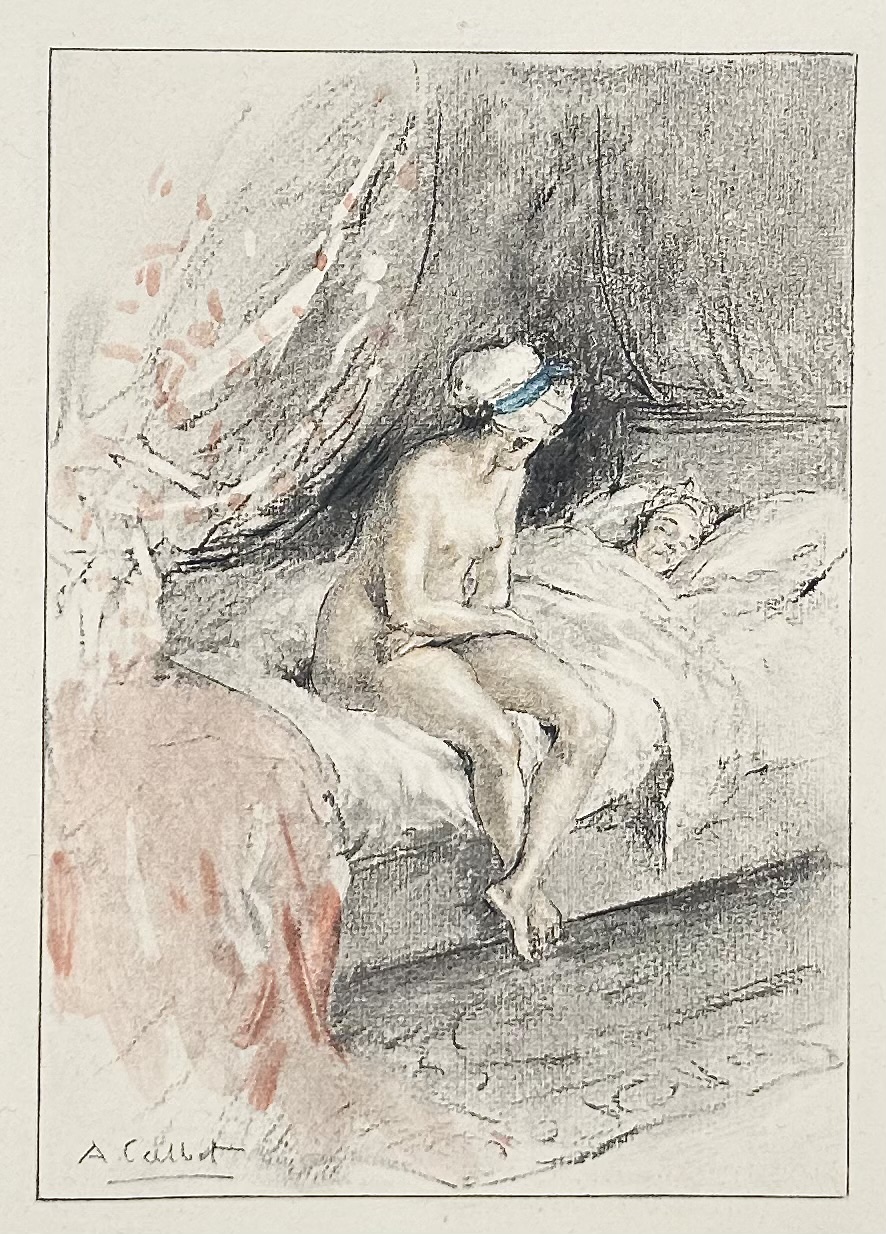
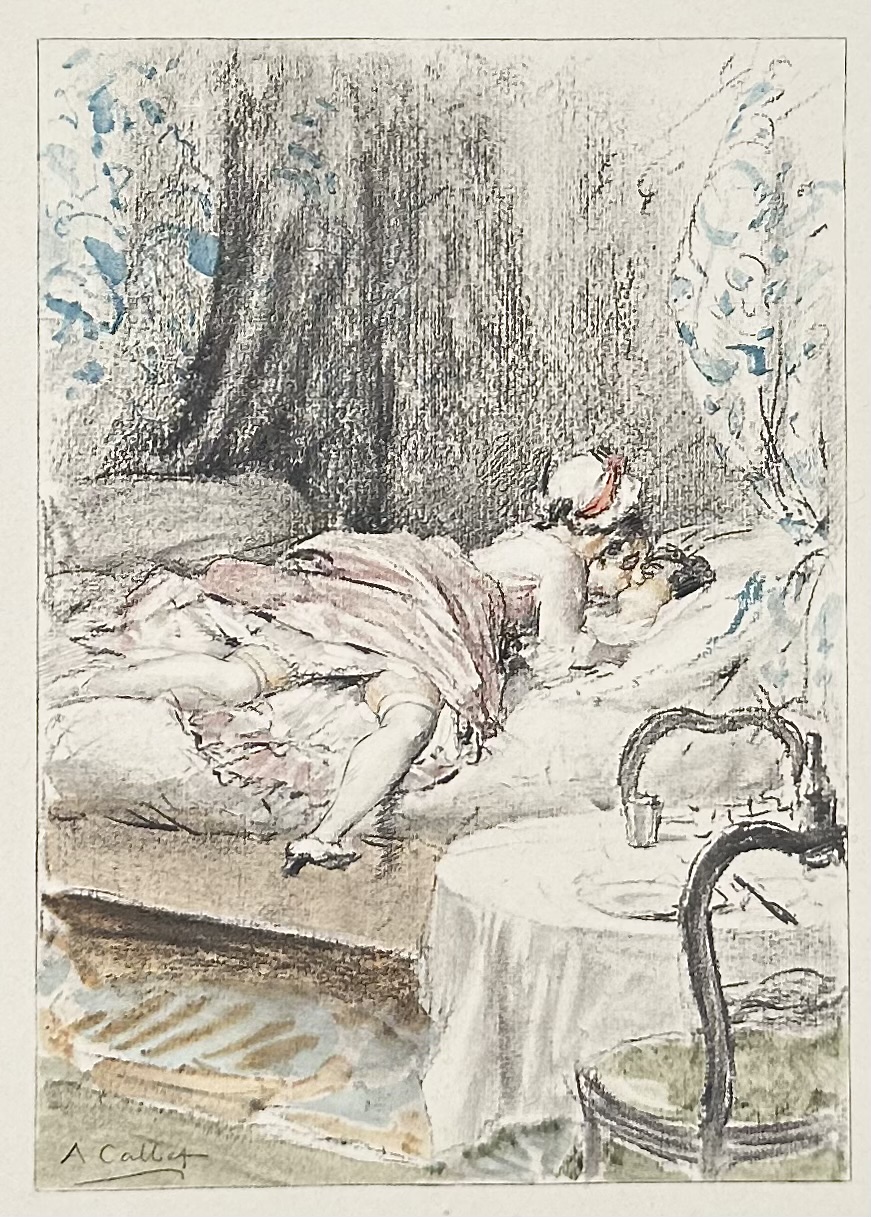
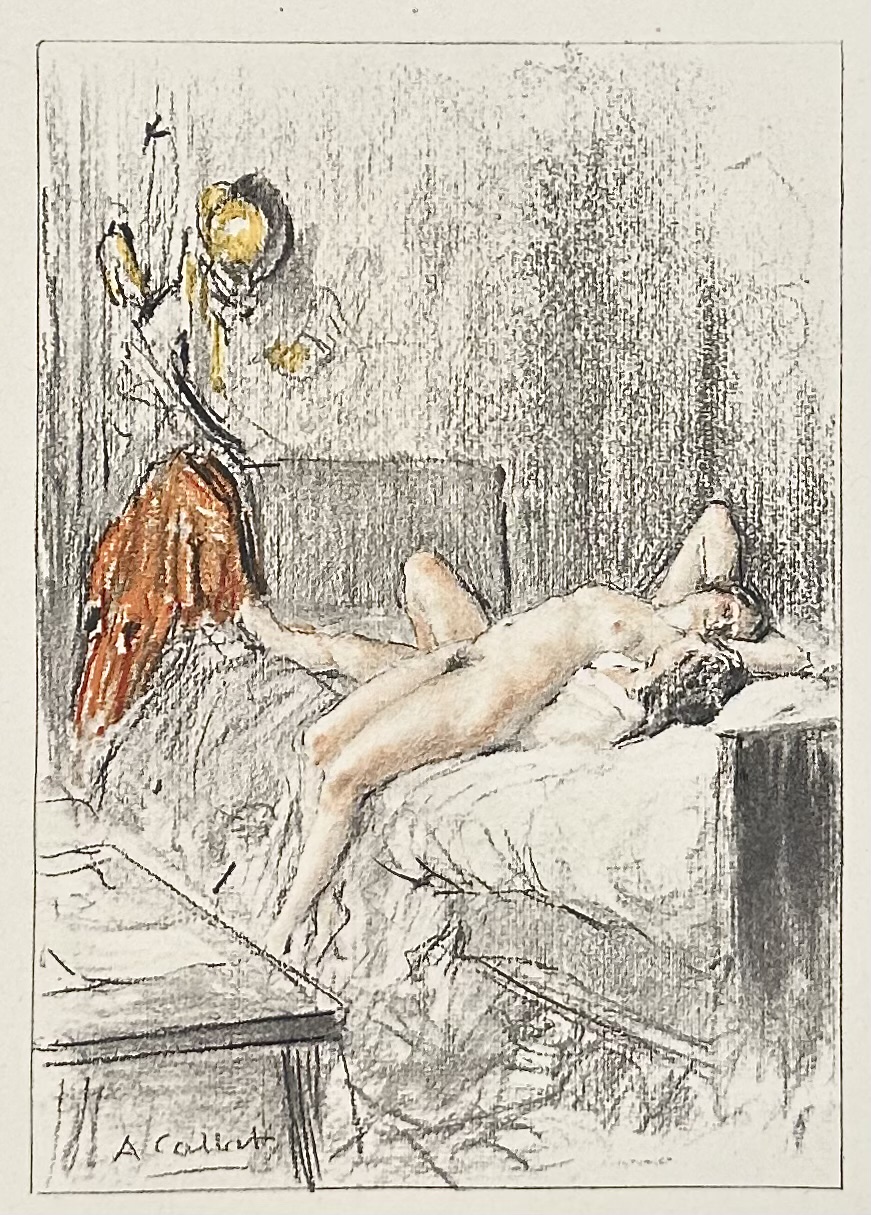
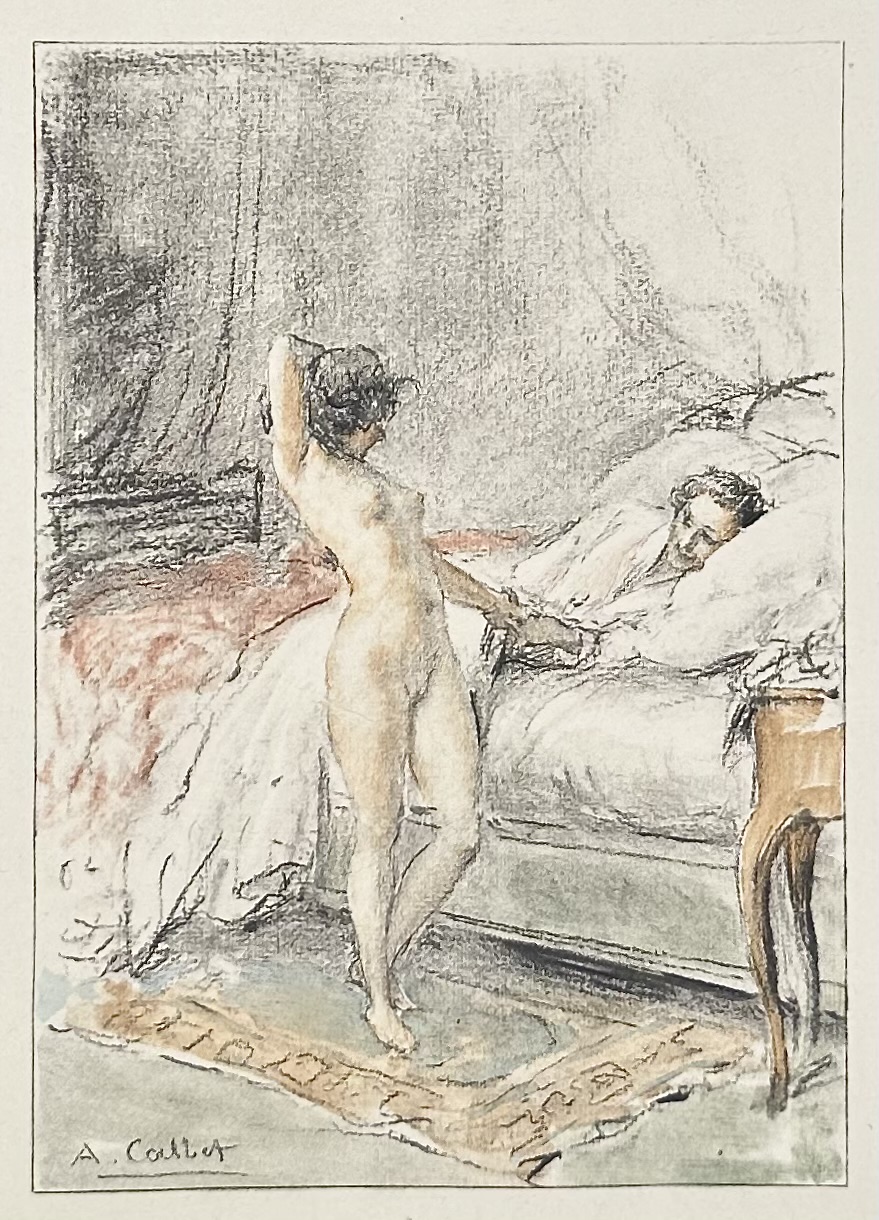
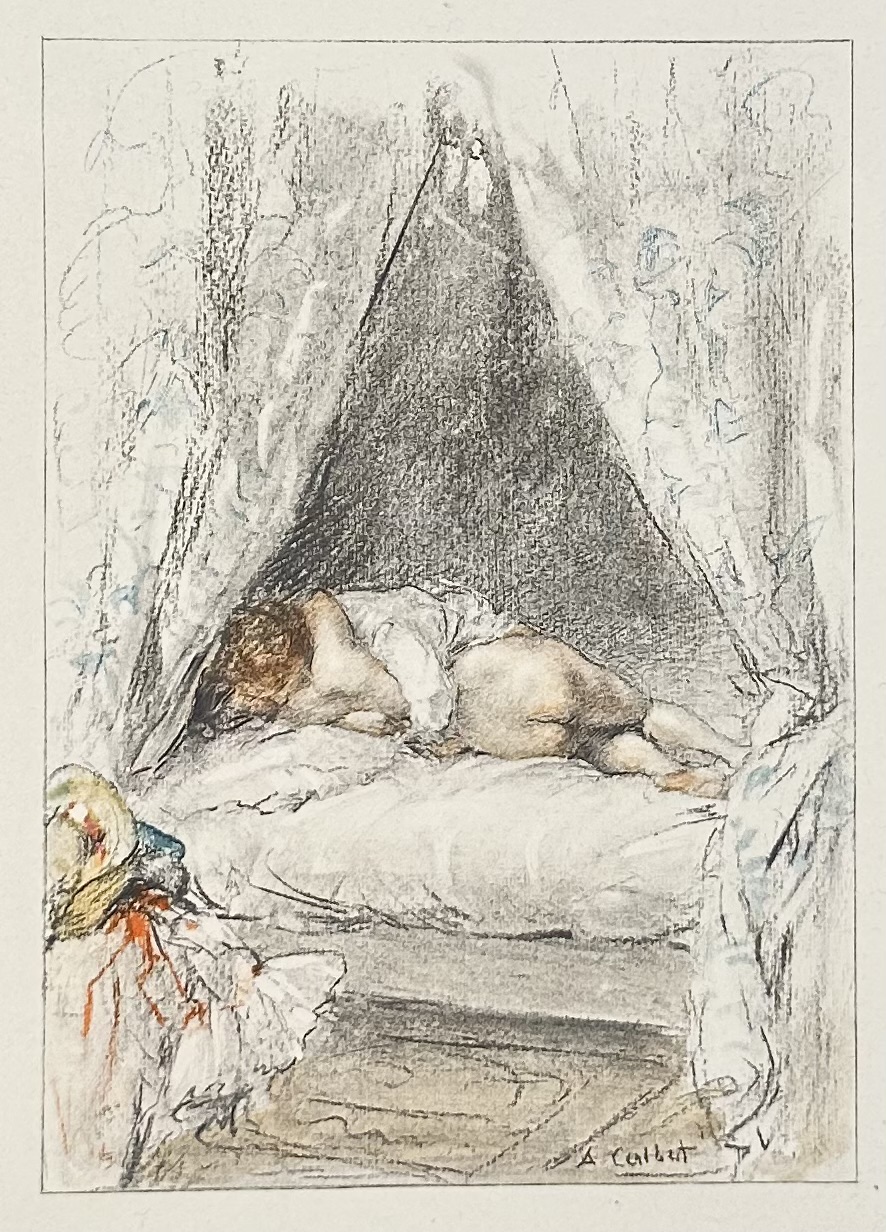
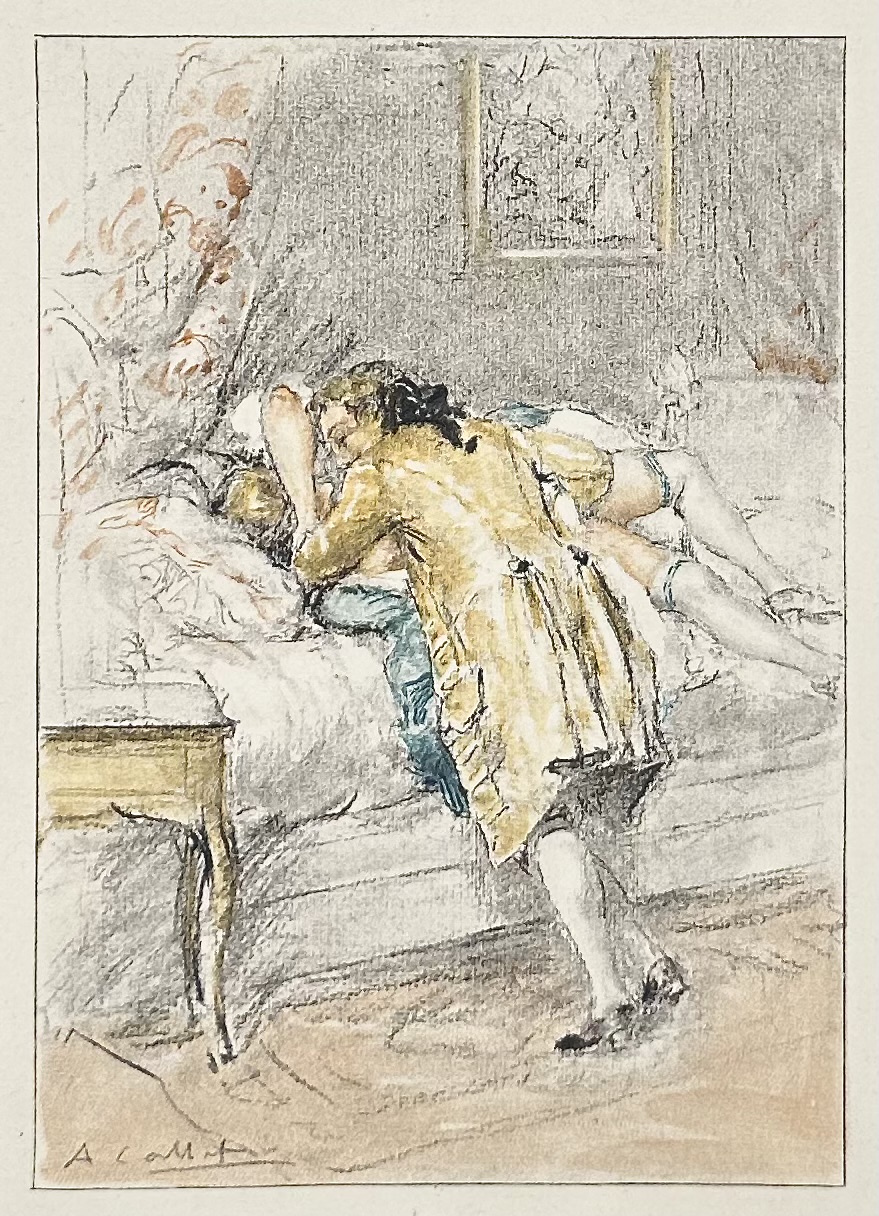
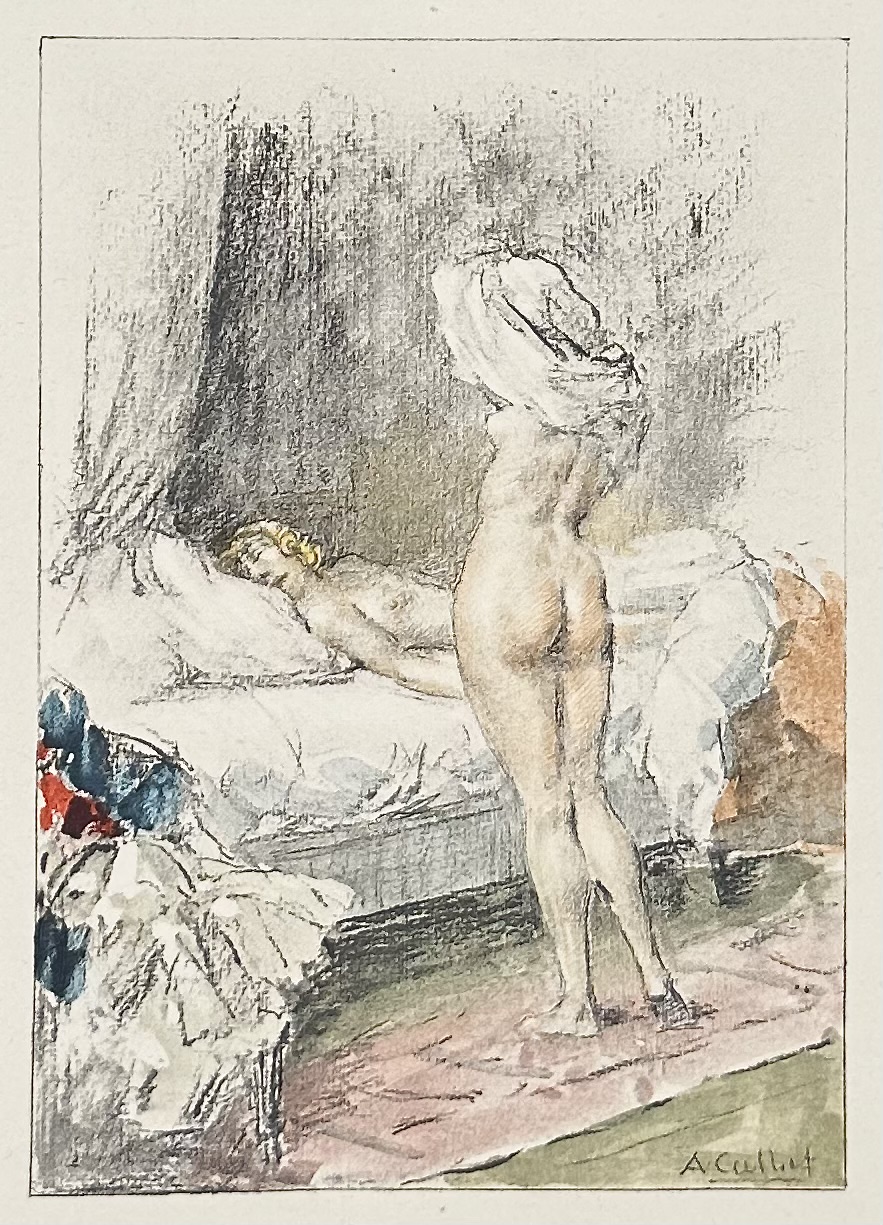
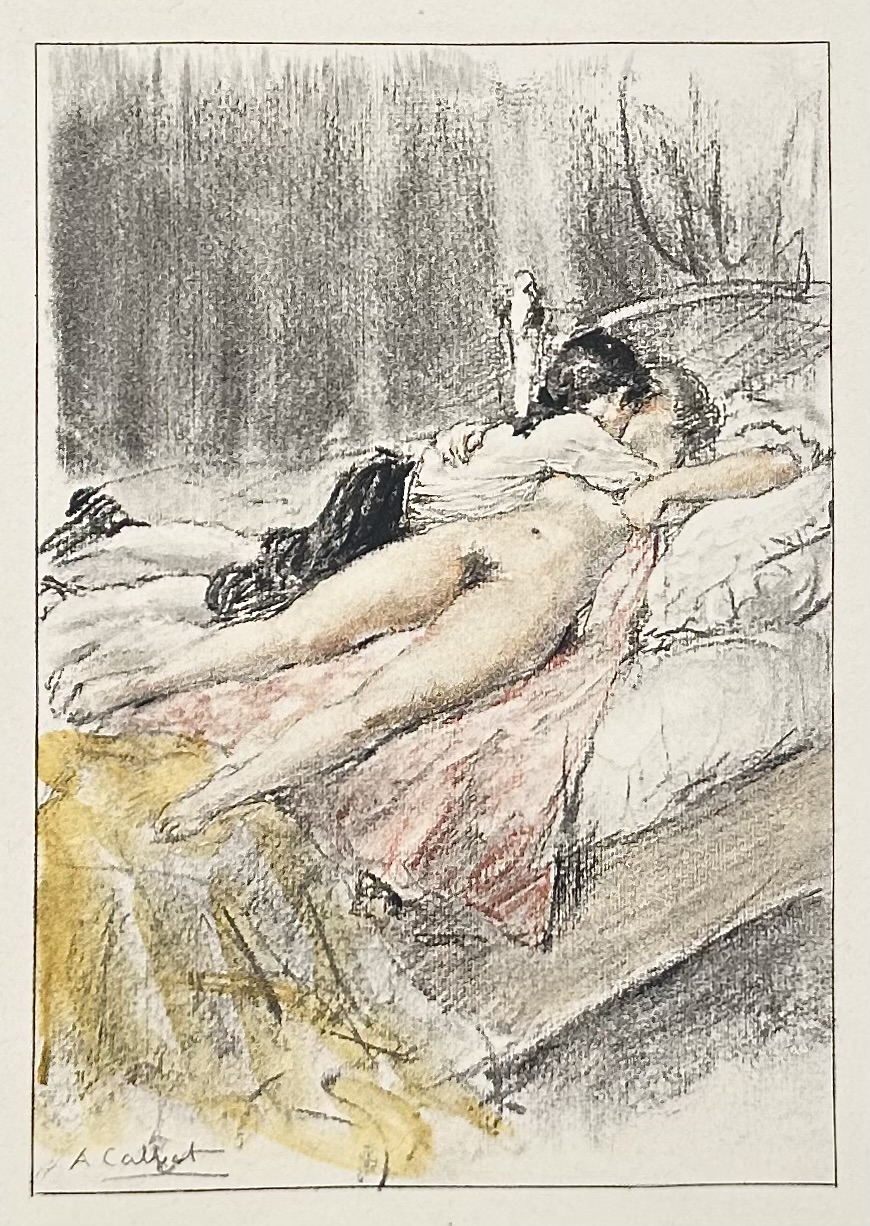
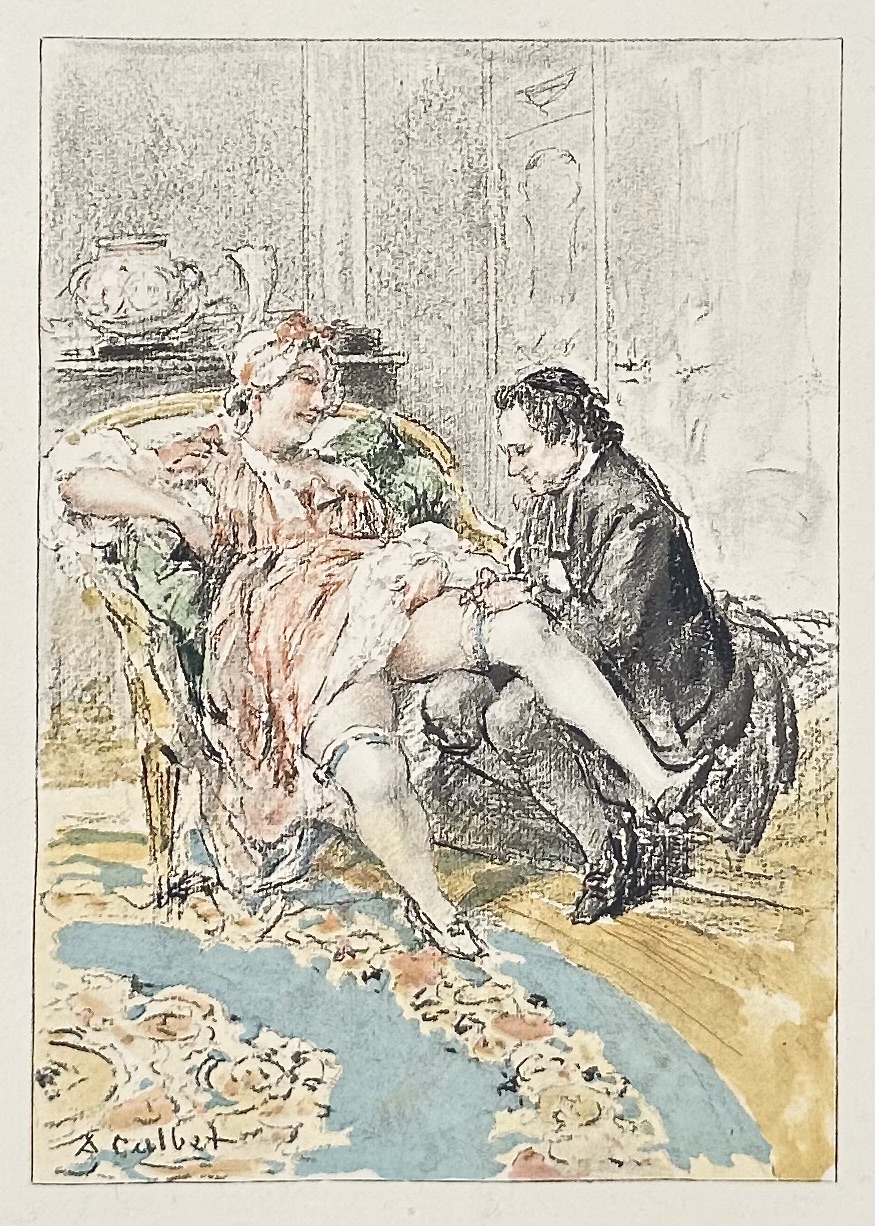
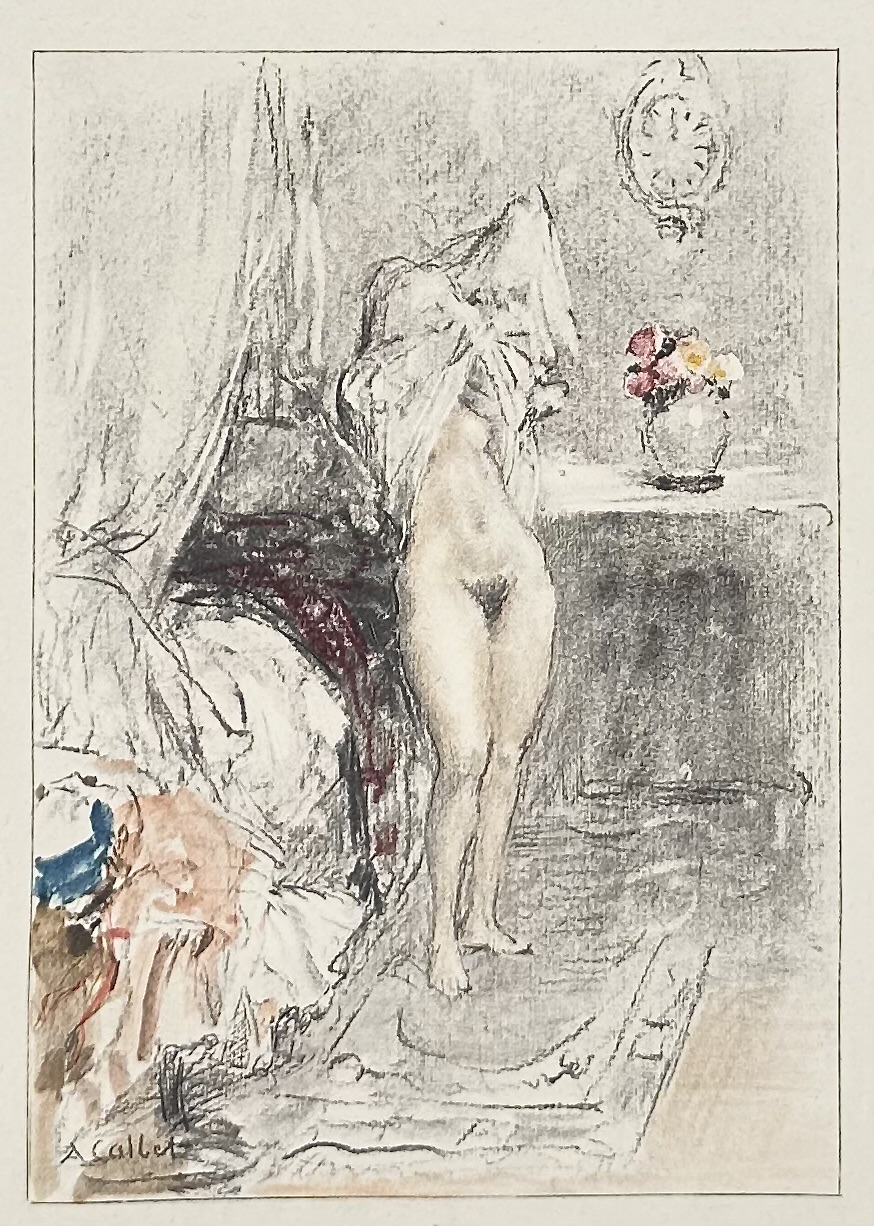
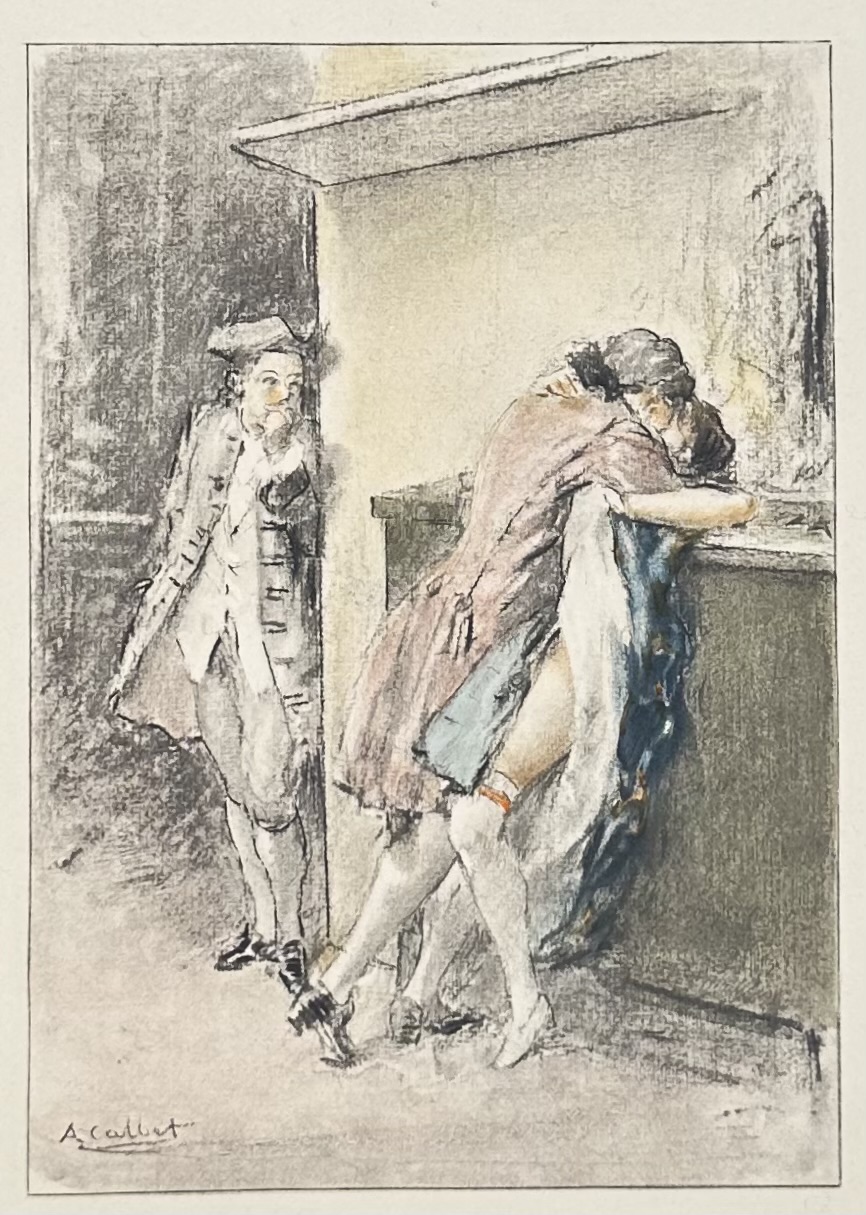
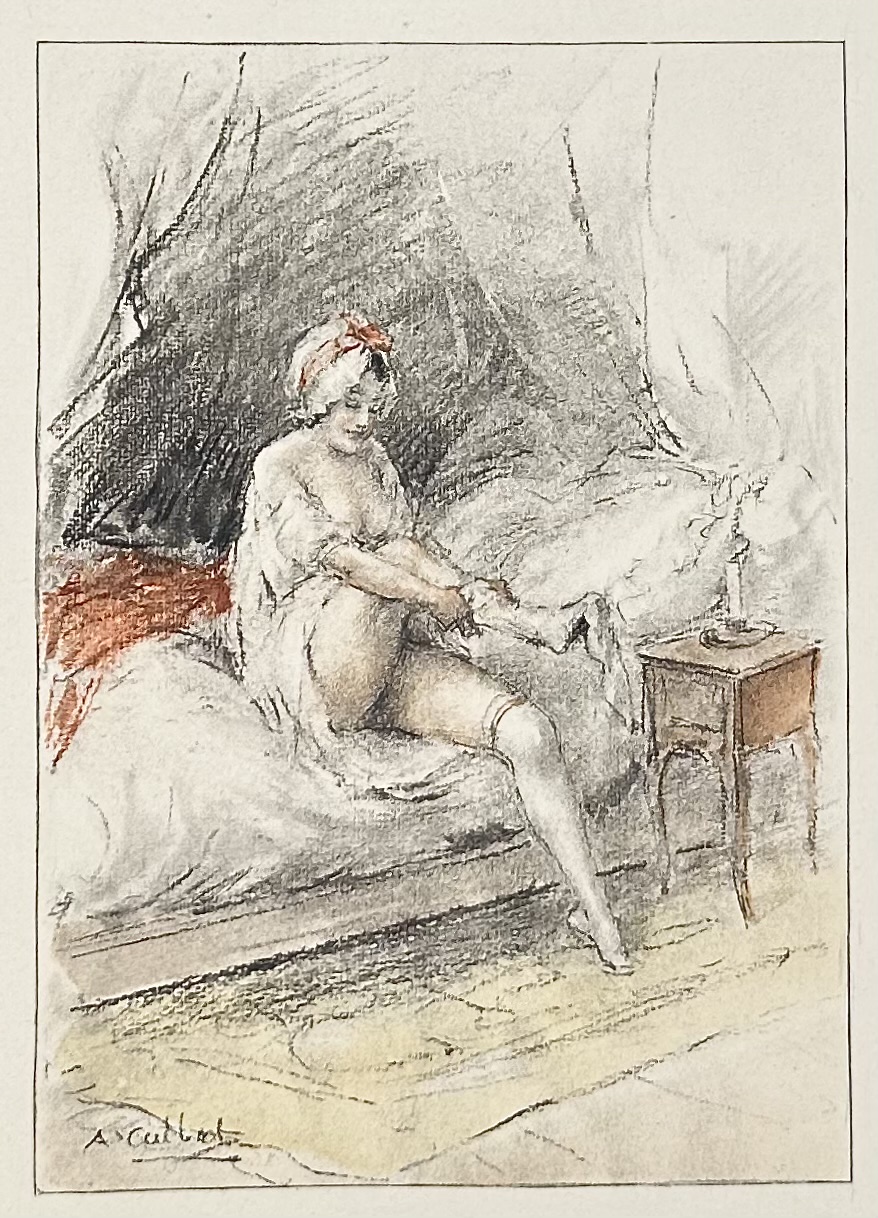 Title-page (red and black): CONTES LIBERTINS | DU DIX-HUITIÈME SIÈCLE | PRÉSENTÉS PAR EDMOND PILON | TRENTE-DEUX ILLUSTRATIONS EN COULEURS | DE | A. CALBET | {fleuron} | PARIS | LE VASSEUR & Cie, ÉDITEURS | 33, Rue de Fleurus ||
Limitation: 587 copies, of which 32 on Japon Impérial (№№ 1-32), 65 on Hollande Van Gilder (№№ 33-97), 490 on Velin a la forme de Rives (№№ 98-587). 25 copies were printed on top of this print run for collaborators, numbered in Roman letters. This copy is № 77 on watermarked Van Gilder Zonnen paper.
Colophon: LE TEXTE DE CET OUVRAGE A | ÉTÉ IMPRIMÉ SUR LES PRESSES | DE CL. JACOUB ET Cie. | LES ILLUSTRATIONS, GRAVÉES PAR L. MACCARD, ONT ÉTÉ | TIRÉES EN TAILLE-DOUCE | PAR A. PORCABEUF ET Cie. | ACHEVÉ D'IMPRIMER, A | PARIS, LE 12 OCTOBRE 1936.
Table of contents:
Histoire de madame Allain – Notice sur le comte de Caylus.
Histoire de Cidal Acmet – Notice sur l'abbé Prevost
Aline, reine de Golconde – Notice sur le chevalier de Boufflers
Cosi-Sancta – notice sur Voltaire.
Cécile, Marine et Bellino – Notice sur Casanova de Seingalt
Histoire de Babet – Notice sur l'abbé Du Laurens
Histoire de Fanny Hill – Notice sur John Cleland.
Louise et Thérèse – Notice sur Rétif de La Bretonne
Contributors:
Pilon, Edmond (French, 1874 – 1945) – compiler
Le Vasseur & Cie – publisher
Calbet, Antoine (French, 1860 – 1942) – artist
Cl. Jacoub et Cie – printer/text
Maccard, Louis (French) – engraver
Porcabeuf, Alfred (French, 1867 – 1952) – printer/plates
Authors:
Caylus, Anne Claude de [comte de Caylus] (French, 1692 – 1765)
Prévost d'Exiles, Antoine François [Abbé Prévost] (French, 1697 – 1763)
Boufflers, Stanislas Jean, chevalier de (French, 1738 – 1815)
Voltaire, François Marie Arouet de (French, 1694 – 1778)
Casanova, Giacomo Girolamo (Italian, 1725 – 1798)
Laurent, Henri-Joseph [Abbé Du Laurens] (French, 1719 – 1793)
Cleland, John (British, c. 1709 – 1789)
Restif [Retif] de la Bretonne, Nicolas Edmé (French, 1734 – 1806)
Title-page (red and black): CONTES LIBERTINS | DU DIX-HUITIÈME SIÈCLE | PRÉSENTÉS PAR EDMOND PILON | TRENTE-DEUX ILLUSTRATIONS EN COULEURS | DE | A. CALBET | {fleuron} | PARIS | LE VASSEUR & Cie, ÉDITEURS | 33, Rue de Fleurus ||
Limitation: 587 copies, of which 32 on Japon Impérial (№№ 1-32), 65 on Hollande Van Gilder (№№ 33-97), 490 on Velin a la forme de Rives (№№ 98-587). 25 copies were printed on top of this print run for collaborators, numbered in Roman letters. This copy is № 77 on watermarked Van Gilder Zonnen paper.
Colophon: LE TEXTE DE CET OUVRAGE A | ÉTÉ IMPRIMÉ SUR LES PRESSES | DE CL. JACOUB ET Cie. | LES ILLUSTRATIONS, GRAVÉES PAR L. MACCARD, ONT ÉTÉ | TIRÉES EN TAILLE-DOUCE | PAR A. PORCABEUF ET Cie. | ACHEVÉ D'IMPRIMER, A | PARIS, LE 12 OCTOBRE 1936.
Table of contents:
Histoire de madame Allain – Notice sur le comte de Caylus.
Histoire de Cidal Acmet – Notice sur l'abbé Prevost
Aline, reine de Golconde – Notice sur le chevalier de Boufflers
Cosi-Sancta – notice sur Voltaire.
Cécile, Marine et Bellino – Notice sur Casanova de Seingalt
Histoire de Babet – Notice sur l'abbé Du Laurens
Histoire de Fanny Hill – Notice sur John Cleland.
Louise et Thérèse – Notice sur Rétif de La Bretonne
Contributors:
Pilon, Edmond (French, 1874 – 1945) – compiler
Le Vasseur & Cie – publisher
Calbet, Antoine (French, 1860 – 1942) – artist
Cl. Jacoub et Cie – printer/text
Maccard, Louis (French) – engraver
Porcabeuf, Alfred (French, 1867 – 1952) – printer/plates
Authors:
Caylus, Anne Claude de [comte de Caylus] (French, 1692 – 1765)
Prévost d'Exiles, Antoine François [Abbé Prévost] (French, 1697 – 1763)
Boufflers, Stanislas Jean, chevalier de (French, 1738 – 1815)
Voltaire, François Marie Arouet de (French, 1694 – 1778)
Casanova, Giacomo Girolamo (Italian, 1725 – 1798)
Laurent, Henri-Joseph [Abbé Du Laurens] (French, 1719 – 1793)
Cleland, John (British, c. 1709 – 1789)
Restif [Retif] de la Bretonne, Nicolas Edmé (French, 1734 – 1806) -
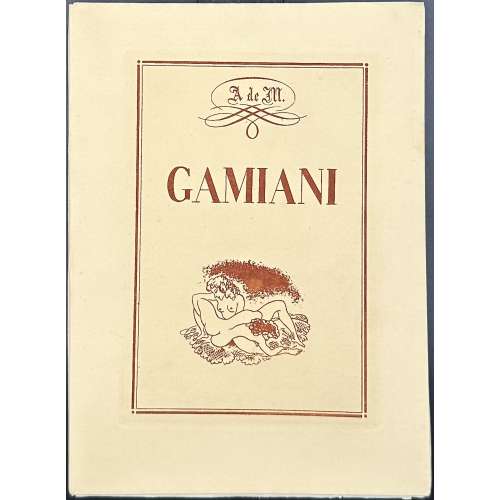 NEWSoftcover volume 200 x 145 mm, in a slipcase, unbound, in French wrappers, sanguine lettering on cream paper, block printed on wove paper with watermark “Marais”, collated 8vo, pp.: [1-6] 7-114 [6], 60 leaves, first and last leaves blank; illustrated with 20 etchings, incl. vignette on front wrapper, two head- and two tailpieces, printed in sanguine; etching on t.p., similar to the one on the front wrapper, printed in black. Limited edition of 250 copies, this is copy № 24. Front wrapper and title-page: in a double frame A de M. | GAMIANI | {vignette} || Colophon: CE LIVRE | IMPRIMÉ AUX DÉPENS | D'UN GROUP D'AMATEURS | SUR PAPIER CHIFFON | A ÉTÉ TIRE | A DEUX CENT CINQUANTE EXEMPLAIRES | LA VENTE AU PUBLIC | EN EST RIGOUREUSEMENT INTERDITE | EXEMPLAIRE N°24 || [This book is printed at the expense of a group of amateurs on rag paper in two hundred and fifty copies; sale to the public is strictly prohibited]. Catalogue raisonné: Dutel III № 1649. Alfred de Musset (French, 1810 – 1857) – author.
NEWSoftcover volume 200 x 145 mm, in a slipcase, unbound, in French wrappers, sanguine lettering on cream paper, block printed on wove paper with watermark “Marais”, collated 8vo, pp.: [1-6] 7-114 [6], 60 leaves, first and last leaves blank; illustrated with 20 etchings, incl. vignette on front wrapper, two head- and two tailpieces, printed in sanguine; etching on t.p., similar to the one on the front wrapper, printed in black. Limited edition of 250 copies, this is copy № 24. Front wrapper and title-page: in a double frame A de M. | GAMIANI | {vignette} || Colophon: CE LIVRE | IMPRIMÉ AUX DÉPENS | D'UN GROUP D'AMATEURS | SUR PAPIER CHIFFON | A ÉTÉ TIRE | A DEUX CENT CINQUANTE EXEMPLAIRES | LA VENTE AU PUBLIC | EN EST RIGOUREUSEMENT INTERDITE | EXEMPLAIRE N°24 || [This book is printed at the expense of a group of amateurs on rag paper in two hundred and fifty copies; sale to the public is strictly prohibited]. Catalogue raisonné: Dutel III № 1649. Alfred de Musset (French, 1810 – 1857) – author. -
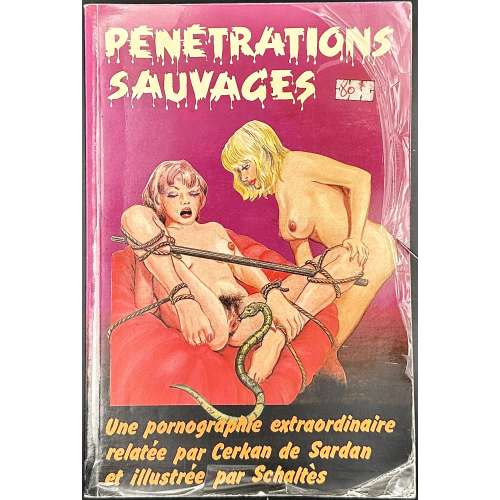 NEWPaperback, 240 x 160 mm, pp. [1-5] 6-156 [4], with black and white illustrations, pictorial front cover: PENETRATIONS SAUVAGES | {vignette} | Une pornographie extraordinaire | relatée par Cerkan de Sardan | et illustrée par Schaltès ||
NEWPaperback, 240 x 160 mm, pp. [1-5] 6-156 [4], with black and white illustrations, pictorial front cover: PENETRATIONS SAUVAGES | {vignette} | Une pornographie extraordinaire | relatée par Cerkan de Sardan | et illustrée par Schaltès || -
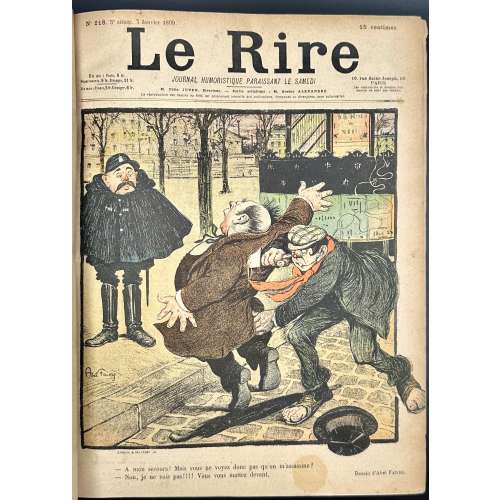 NEWLe Rire : journal humoristique hebdomadaire, 1899, 51 issues №№ 218-269 (lacking № 233 April 22nd), quarter bound by a contemporary owner in dark green faux morocco over marbled boards, marbled endpapers, gilt lettering to spine, 307 x 250 mm.Publisher: Félix Juven (French, 1862 – 1947) Printer: Bertin et Cie Artists: Jules Abel Faivre (French, 1867 – 1945) Lucien Marie François Métivet (French, 1863 – 1932) Charles Lucien Léandre (French, 862 – 1934) Jean-Louis Forain (French, 1852 – 1931) Jules Maurice Radiguet (French, 1866 – 1941) Louis-Christian Does [Döes, Doës] (French, 1859 – 1944) René Georges Hermann-Paul (French, 1864 – 1940) Caran d’Ache [Emmanuel Poiré] (French, 1858 – 1909) Charles Huard (French, 1874 – 1965) Benjamin Rabier (French, 1864 – 1939) Georges Meunier (French, 1869 – 1942) Pierre-Georges Jeanniot (Swiss-French, 1848 – 1934) Guydo [Joseph Robert Guillaume Le Barrois d'Orgeval] (French, 1868 – 1930) Henri [Henry] Gerbault (French, 1863 – 1930) Adolphe Willette (French, 1857 – 1926) Auguste Roubille (French, 1872 – 1955) Leonetto Cappiello (French, 1875 – 1942) Fernand Fau (French, 1858 – 1915) Georges Delaw [Deleau] (French, 1871 – 1938) Georges Tiret-Bognet (French, 1855 – 1935) Édouard Couturier (French, 1869 – 1903) Jean Villemot (French, 1880 – 1958) Guy Kadell (French, 18?? – 19??) Henri Louis Avelot (French, 1873 – 1935) Jan [Jean] Duch
NEWLe Rire : journal humoristique hebdomadaire, 1899, 51 issues №№ 218-269 (lacking № 233 April 22nd), quarter bound by a contemporary owner in dark green faux morocco over marbled boards, marbled endpapers, gilt lettering to spine, 307 x 250 mm.Publisher: Félix Juven (French, 1862 – 1947) Printer: Bertin et Cie Artists: Jules Abel Faivre (French, 1867 – 1945) Lucien Marie François Métivet (French, 1863 – 1932) Charles Lucien Léandre (French, 862 – 1934) Jean-Louis Forain (French, 1852 – 1931) Jules Maurice Radiguet (French, 1866 – 1941) Louis-Christian Does [Döes, Doës] (French, 1859 – 1944) René Georges Hermann-Paul (French, 1864 – 1940) Caran d’Ache [Emmanuel Poiré] (French, 1858 – 1909) Charles Huard (French, 1874 – 1965) Benjamin Rabier (French, 1864 – 1939) Georges Meunier (French, 1869 – 1942) Pierre-Georges Jeanniot (Swiss-French, 1848 – 1934) Guydo [Joseph Robert Guillaume Le Barrois d'Orgeval] (French, 1868 – 1930) Henri [Henry] Gerbault (French, 1863 – 1930) Adolphe Willette (French, 1857 – 1926) Auguste Roubille (French, 1872 – 1955) Leonetto Cappiello (French, 1875 – 1942) Fernand Fau (French, 1858 – 1915) Georges Delaw [Deleau] (French, 1871 – 1938) Georges Tiret-Bognet (French, 1855 – 1935) Édouard Couturier (French, 1869 – 1903) Jean Villemot (French, 1880 – 1958) Guy Kadell (French, 18?? – 19??) Henri Louis Avelot (French, 1873 – 1935) Jan [Jean] Duch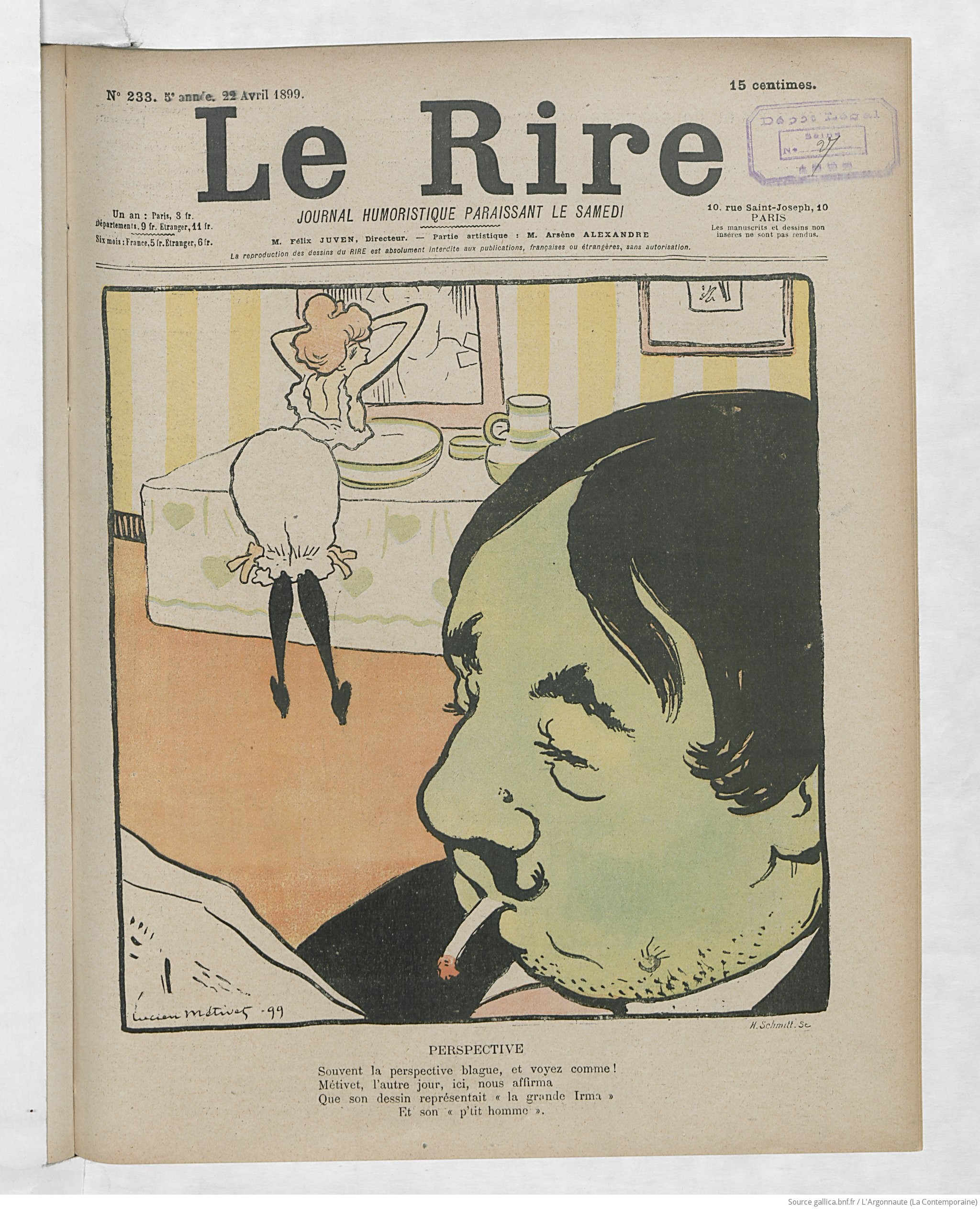
№ 233 April 22nd
-
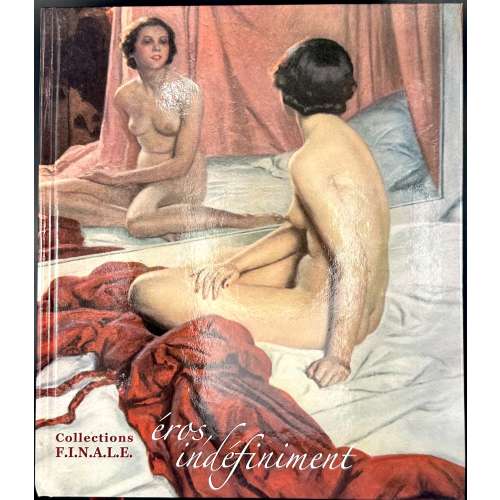 NEWHardcover volume, 297 x 256 x 40 mm, glossy pictorial boards, pp. [1-8] 9-428 [4], profusely illustrated, text in French. F.I.N.A.L.E. stands for Foundation Internationale d’Arts et Litératures Érotiques (Foundation of Erotic Arts and Literatures, established on December 12, 1996 in Lausanne, Switzerland. Title-page: éros, | indéfiniment | Collections F.I.N.A.L.E. | { HumuS, publisher’s device} ||
NEWHardcover volume, 297 x 256 x 40 mm, glossy pictorial boards, pp. [1-8] 9-428 [4], profusely illustrated, text in French. F.I.N.A.L.E. stands for Foundation Internationale d’Arts et Litératures Érotiques (Foundation of Erotic Arts and Literatures, established on December 12, 1996 in Lausanne, Switzerland. Title-page: éros, | indéfiniment | Collections F.I.N.A.L.E. | { HumuS, publisher’s device} || -
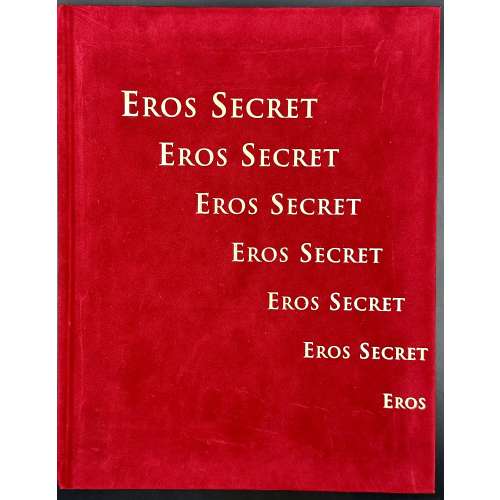 NEWHardcover volume, 290 x 225 mm, bound in scarlet velveteen with gilt lettering to front and spine, gilt vignette and lettering to back; pp.: [1-8] 9-204 [4], profusely illustrated; text in French and English. ISBN : 2-940127-37-9. Title-page (yellow on red paper): EROS SECRET | OBJETS EROTIQUES A TRANSFORMATION | EROTIC TRANSFORMATION OBJECTS | Photographies et chorégraphie : Véronique Willemin | Photographer and choreography || “The ensemble of 150 objects presented belongs to one single collector. The manner in which the author met him at the airport of Larnaca, then on a yacht in the Mediterranean sea, resembles more a novel by Gérard de Villiers than the preface of a curator but has its own touch of spice” [Art of the day Weekly].
NEWHardcover volume, 290 x 225 mm, bound in scarlet velveteen with gilt lettering to front and spine, gilt vignette and lettering to back; pp.: [1-8] 9-204 [4], profusely illustrated; text in French and English. ISBN : 2-940127-37-9. Title-page (yellow on red paper): EROS SECRET | OBJETS EROTIQUES A TRANSFORMATION | EROTIC TRANSFORMATION OBJECTS | Photographies et chorégraphie : Véronique Willemin | Photographer and choreography || “The ensemble of 150 objects presented belongs to one single collector. The manner in which the author met him at the airport of Larnaca, then on a yacht in the Mediterranean sea, resembles more a novel by Gérard de Villiers than the preface of a curator but has its own touch of spice” [Art of the day Weekly]. -
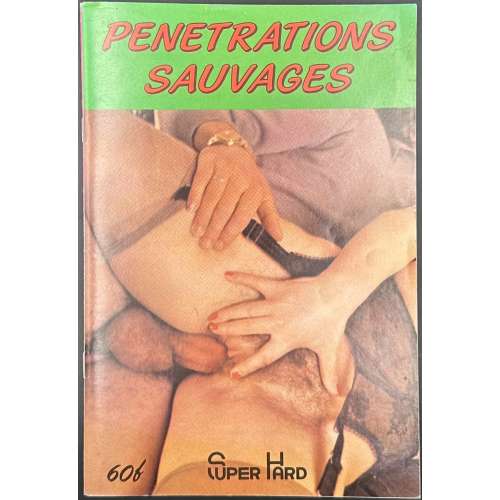 NEWFrench illustrated pornographic magazine (ouvrage illustrè de photographies pornographiques), in pictorial wrappers, 235 x 160 mm, 16 leaves incl. wrappers, unpaginated.
NEWFrench illustrated pornographic magazine (ouvrage illustrè de photographies pornographiques), in pictorial wrappers, 235 x 160 mm, 16 leaves incl. wrappers, unpaginated. -
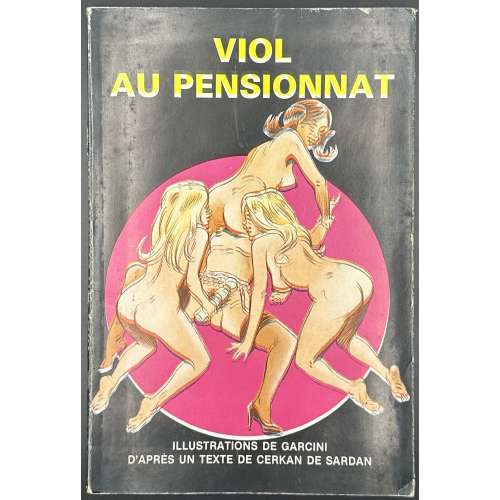 NEWSoftcover, French flapped pictorial wrappers, 240 x 160 mm, translated title: Rape at the boarding school, pp. [1-6] 7-164 [4], 40 black and white illustrations by Garcini. Title-page: D’après un texte de | CERKAN DE SARDAN | VIOL | AU PENSIONNAT | illustrations de | GARCINI ||
NEWSoftcover, French flapped pictorial wrappers, 240 x 160 mm, translated title: Rape at the boarding school, pp. [1-6] 7-164 [4], 40 black and white illustrations by Garcini. Title-page: D’après un texte de | CERKAN DE SARDAN | VIOL | AU PENSIONNAT | illustrations de | GARCINI || -
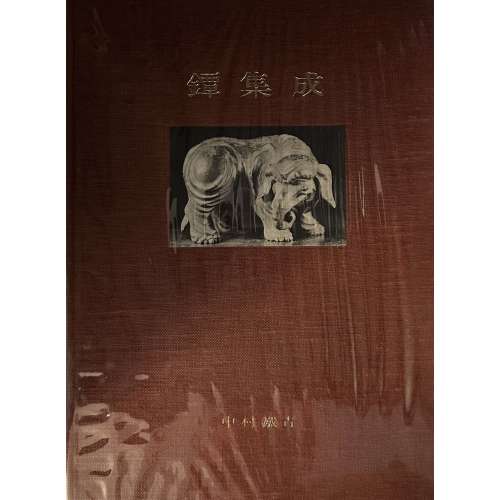 NEWA large hardcover volume, 370 x 265 x 53 mm, bound in burgundy cloth with pasted-in b/w photograph and gilt lettering to front, gilt lettering to spine, in plastic dust jacket, in a slipcase, in a cardboard shipping box, pp. [2] 1-522 [2], 128 leaves total; limited edition of 1000 copies. Author: Nakamura Tessei [中村鐵青] Seller's description: Tsuba Shusei by Nakamura. 1963. Of a limited edition of 1,000. Clothbound with plastic jacket, slipcase, and cardboard storage box, 11 ½ x 14 ½”, 522 heavy stock pages in Japanese. This is a very impressive book. Thousands of tsuba, from Kamakura to late Edo and arranged by school. are illustrated (24 in colour photos and the rest in black & white) and described. If there is a tsuba bible this might be it; there can’t be a more comprehensive book on the subject. The storage box is shelf worn, the slipcase is just a bit toned; the book is in excellentt condition. Produced by Chuokoron-Shinsha, Inc. [株式会社中央公論新社] Publisher: 銀集成刊行会 Production details: 鐵集成 第617番 昭和38年2月10日発行 限定1,000部 定価 10,000円 オフセット単色印刷:マイク印刷 オフセット原色印刷:大日本印刷 著者中村鐵青 製作 中央公論事業出版 発行所 銀集成刊行会 活版印刷:精興社 製本:協和製本 本文用紙:三菱製紙 表紙:望月
NEWA large hardcover volume, 370 x 265 x 53 mm, bound in burgundy cloth with pasted-in b/w photograph and gilt lettering to front, gilt lettering to spine, in plastic dust jacket, in a slipcase, in a cardboard shipping box, pp. [2] 1-522 [2], 128 leaves total; limited edition of 1000 copies. Author: Nakamura Tessei [中村鐵青] Seller's description: Tsuba Shusei by Nakamura. 1963. Of a limited edition of 1,000. Clothbound with plastic jacket, slipcase, and cardboard storage box, 11 ½ x 14 ½”, 522 heavy stock pages in Japanese. This is a very impressive book. Thousands of tsuba, from Kamakura to late Edo and arranged by school. are illustrated (24 in colour photos and the rest in black & white) and described. If there is a tsuba bible this might be it; there can’t be a more comprehensive book on the subject. The storage box is shelf worn, the slipcase is just a bit toned; the book is in excellentt condition. Produced by Chuokoron-Shinsha, Inc. [株式会社中央公論新社] Publisher: 銀集成刊行会 Production details: 鐵集成 第617番 昭和38年2月10日発行 限定1,000部 定価 10,000円 オフセット単色印刷:マイク印刷 オフセット原色印刷:大日本印刷 著者中村鐵青 製作 中央公論事業出版 発行所 銀集成刊行会 活版印刷:精興社 製本:協和製本 本文用紙:三菱製紙 表紙:望月 -
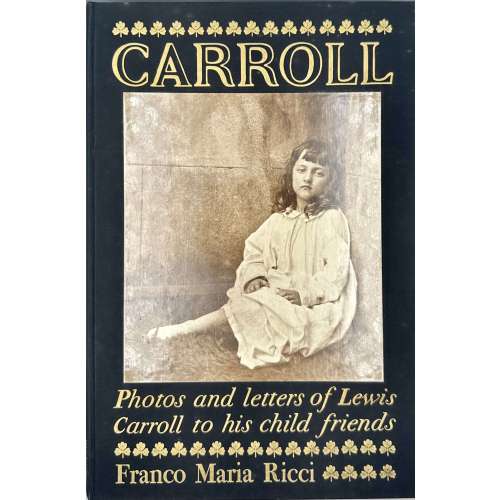 NEWHardcover volume, 355 x 240 mm, bound in black cloth with gilt lettering to front and spine with a photo portrait of Mary Millais (1860-1944), in a black cloth clam-shell box 370 x 253 x 40 mm, with a shamrock diaper black paper adorned with publisher’s coat of arms pasted to the front. Pp.: [1-12] 13-213 [3], with 41 glued-in photomechanically reproduced photographs, chiefly from the Gernsheim Collection at the University of Texas, two of them of Alice Liddell (pp. 123 and 127). Printed on hand-made blue laid paper. Edition is limited to 3,000 copies, of which this is copy № 1200. Title-page: Lewis Carroll | Photos and Letters | to His Child Friends | Edited by Guido Almansi | Notes by | Brassai and Helmut Gernsheim | Franco Maria Ricci | 1975 || Colophon: This volume was printed in Milan, Italy, in the month of November 1975, under the direction of Franco Maria Ricci. The hand-made paper is the work of the Pietro Miliani mills at Fabriano. This first edition consists of three thousand numbered copies. Copy n. [1200]. Facsimile. Seller’s description: Near Fine condition Hardcover Signed by Franco Maria Ricci on the colophon page, Numbered and Limited Edition #1200/3000 of copies. Includes Notes by Brassai and Helmut Gernsheim, with 41 tipped-in sepia-toned photographs, 213 pages. "The Signs of Man Volume 3". Black boards bound in Orient silk with gold engraved lettering on the spine and cover and a sepia-toned photograph affixed to the front cover, handmade Ingres pastel paper manufactured by Cartiere Milliani in Fabrianoo with decorated endpapers and deckled fore-edge. Housed in a black clamshell case with clover leaf pattern in Very Good + condition with the exception that there is no spine label and very light wear to the extremities. Oversize folio: 9" x 13 3/4" Contributors: Carroll, Lewis (British, 1832 – 1898) – Author/Photographer Ricci, Franco Maria (Italian, 1937 – 2020) – publisher Almansi, Guido (Italian, 1931 – 2001) – editor Brassai [Halász, Gyula] (Hungarian–French, 1899 – 1984) – notes Gernsheim, Helmut (Jewish-German, 1913 – 20 July 1995) – notes
NEWHardcover volume, 355 x 240 mm, bound in black cloth with gilt lettering to front and spine with a photo portrait of Mary Millais (1860-1944), in a black cloth clam-shell box 370 x 253 x 40 mm, with a shamrock diaper black paper adorned with publisher’s coat of arms pasted to the front. Pp.: [1-12] 13-213 [3], with 41 glued-in photomechanically reproduced photographs, chiefly from the Gernsheim Collection at the University of Texas, two of them of Alice Liddell (pp. 123 and 127). Printed on hand-made blue laid paper. Edition is limited to 3,000 copies, of which this is copy № 1200. Title-page: Lewis Carroll | Photos and Letters | to His Child Friends | Edited by Guido Almansi | Notes by | Brassai and Helmut Gernsheim | Franco Maria Ricci | 1975 || Colophon: This volume was printed in Milan, Italy, in the month of November 1975, under the direction of Franco Maria Ricci. The hand-made paper is the work of the Pietro Miliani mills at Fabriano. This first edition consists of three thousand numbered copies. Copy n. [1200]. Facsimile. Seller’s description: Near Fine condition Hardcover Signed by Franco Maria Ricci on the colophon page, Numbered and Limited Edition #1200/3000 of copies. Includes Notes by Brassai and Helmut Gernsheim, with 41 tipped-in sepia-toned photographs, 213 pages. "The Signs of Man Volume 3". Black boards bound in Orient silk with gold engraved lettering on the spine and cover and a sepia-toned photograph affixed to the front cover, handmade Ingres pastel paper manufactured by Cartiere Milliani in Fabrianoo with decorated endpapers and deckled fore-edge. Housed in a black clamshell case with clover leaf pattern in Very Good + condition with the exception that there is no spine label and very light wear to the extremities. Oversize folio: 9" x 13 3/4" Contributors: Carroll, Lewis (British, 1832 – 1898) – Author/Photographer Ricci, Franco Maria (Italian, 1937 – 2020) – publisher Almansi, Guido (Italian, 1931 – 2001) – editor Brassai [Halász, Gyula] (Hungarian–French, 1899 – 1984) – notes Gernsheim, Helmut (Jewish-German, 1913 – 20 July 1995) – notes -
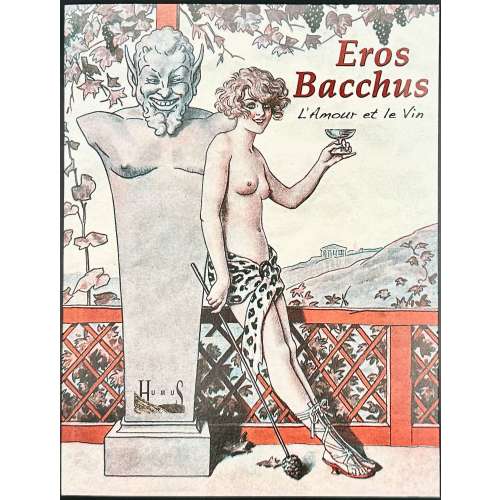 NEWBound in full-colour pictorial wrappers with French flaps, 250 x 190 x 35 mm, 1,311 g by weight, profusely illustrated volume, pp. [1-4] 5-427 [5], 216 leaves total. Title-page: {vignette} | EROS BACCHUS | L'amour et le vin | {publisher's device} || Exhibition at Château Musée du vin et de la vigne, à Aigle, du 24 mai 2014 au 28 février 2015. Text by Michel Froidevaux. Original description : Depuis l'apparition du vignoble, l'amour et le vin sont inséparables. Tantôt boisson des dieux, tantôt breuvage des poètes, le vin a la vertu de rapprocher les êtres. De la riche mythologie antique - Dionysos et Bacchus - aux fêtes des confréries contemporaines, le vin enflamme l'imaginaire et génère de la convivialité. L'idée est de proposer un parcours ludique et culturel, badin et savant pour aller par siècles et contrées à la découverte des plaisirs du boire et des méandres du désir. Livre richement illustré d'un millier d'images (dessins, objets, cartes postales,...) avec la participation d'une quarantaine d'artistes contemporains qui ont créé spécialement une œuvre. Machine translation: Love and wine have been inseparable since the dawn of the vineyard. Sometimes the drink of the gods, sometimes the beverage of poets, wine has the virtue of bringing people together. From the rich mythology of antiquity - Dionysus and Bacchus - to contemporary brotherhood celebrations, wine fires the imagination and generates conviviality. The idea is to offer a playful and cultural journey, both playful and learned, through centuries and lands, to discover the pleasures of drinking and the twists and turns of desire. The book is richly illustrated with some 1,000 images (drawings, objects, postcards, etc.), featuring works by some 40 contemporary artists.
NEWBound in full-colour pictorial wrappers with French flaps, 250 x 190 x 35 mm, 1,311 g by weight, profusely illustrated volume, pp. [1-4] 5-427 [5], 216 leaves total. Title-page: {vignette} | EROS BACCHUS | L'amour et le vin | {publisher's device} || Exhibition at Château Musée du vin et de la vigne, à Aigle, du 24 mai 2014 au 28 février 2015. Text by Michel Froidevaux. Original description : Depuis l'apparition du vignoble, l'amour et le vin sont inséparables. Tantôt boisson des dieux, tantôt breuvage des poètes, le vin a la vertu de rapprocher les êtres. De la riche mythologie antique - Dionysos et Bacchus - aux fêtes des confréries contemporaines, le vin enflamme l'imaginaire et génère de la convivialité. L'idée est de proposer un parcours ludique et culturel, badin et savant pour aller par siècles et contrées à la découverte des plaisirs du boire et des méandres du désir. Livre richement illustré d'un millier d'images (dessins, objets, cartes postales,...) avec la participation d'une quarantaine d'artistes contemporains qui ont créé spécialement une œuvre. Machine translation: Love and wine have been inseparable since the dawn of the vineyard. Sometimes the drink of the gods, sometimes the beverage of poets, wine has the virtue of bringing people together. From the rich mythology of antiquity - Dionysus and Bacchus - to contemporary brotherhood celebrations, wine fires the imagination and generates conviviality. The idea is to offer a playful and cultural journey, both playful and learned, through centuries and lands, to discover the pleasures of drinking and the twists and turns of desire. The book is richly illustrated with some 1,000 images (drawings, objects, postcards, etc.), featuring works by some 40 contemporary artists. -
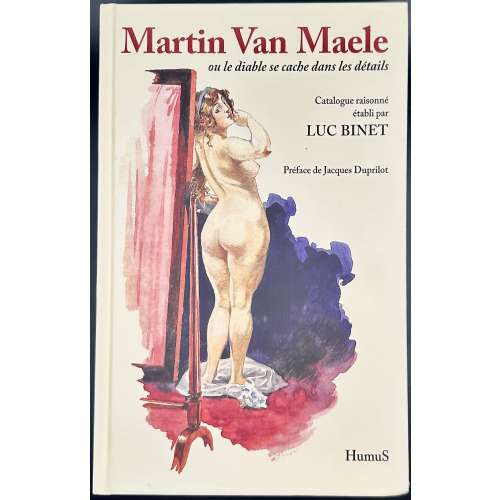 NEWHardcover volume, 292 x 185 x 65 mm, pictorial cream paper over cardboard, black and burgundy lettering to spine and covers; pagination: [4] h.t./imprint, t.p./photo, caption; i-vi, 7-921 [3] colophon; limitation/blank, total 464 leaves. A heavy volume of over 3 kg. Front cover: Martin Van Maele | ou le diable se cache dans détails | Catalogue raisonné | établi par | LUC BINET | Preface de Jacques Duprilot | {vignette} | HumuS || Title-page (red and black): MARTIN VAN MAELE | (1863-1926) | ou le diable se cache dans détails | Catalogue raisonné | établi et commenté par | LUC BINET | Introduction de Jacques Duprilot | {publisher’s device} | ÉDITIONS HUMUS || Edition limited to 333 copies. Maele, Martin van [Martin, Maurice François Alfred] (French, 1863 – 1926)
NEWHardcover volume, 292 x 185 x 65 mm, pictorial cream paper over cardboard, black and burgundy lettering to spine and covers; pagination: [4] h.t./imprint, t.p./photo, caption; i-vi, 7-921 [3] colophon; limitation/blank, total 464 leaves. A heavy volume of over 3 kg. Front cover: Martin Van Maele | ou le diable se cache dans détails | Catalogue raisonné | établi par | LUC BINET | Preface de Jacques Duprilot | {vignette} | HumuS || Title-page (red and black): MARTIN VAN MAELE | (1863-1926) | ou le diable se cache dans détails | Catalogue raisonné | établi et commenté par | LUC BINET | Introduction de Jacques Duprilot | {publisher’s device} | ÉDITIONS HUMUS || Edition limited to 333 copies. Maele, Martin van [Martin, Maurice François Alfred] (French, 1863 – 1926) -
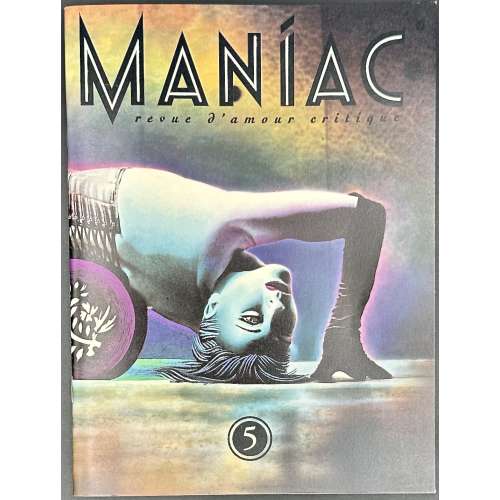 NEWFive issues in publisher's pictorial wrappers, 205 x 155 mm, profusely illustrated French erotic magazines. Published by Éditions Astarté : 58, rue Amelot, 75011 Paris. Rédacteur en chef : Gilles Berquet ; Comité de rédaction : Mïrka Lugosi, Jocelyne and Alexandre Dupouy. Maniac: revue d’amour critique, № 5, octobre 1996, 48p. — Paris: Astarté, 1996 ; ISSN 1261-484X. Maniac: revue d’amour critique, № 6, juin 1997, 48p. — Paris: Astarté, 1996 ; ISSN 1261-484X. Maniac: revue d’amour critique, № 7, octobre 1998, 48p. — Paris: Astarté, 1996 ; ISSN 1261-484X. Maniac: revue d’amour critique, № 8, décembre 2000, 70p (unpag.). — Paris: Astarté, 1996 ; ISSN 1261-484X. Maniac: revue d’amour critique, № 9, janvier 2004, 48p. — Paris: Astarté, 1996 ; ISSN 1261-484X.
NEWFive issues in publisher's pictorial wrappers, 205 x 155 mm, profusely illustrated French erotic magazines. Published by Éditions Astarté : 58, rue Amelot, 75011 Paris. Rédacteur en chef : Gilles Berquet ; Comité de rédaction : Mïrka Lugosi, Jocelyne and Alexandre Dupouy. Maniac: revue d’amour critique, № 5, octobre 1996, 48p. — Paris: Astarté, 1996 ; ISSN 1261-484X. Maniac: revue d’amour critique, № 6, juin 1997, 48p. — Paris: Astarté, 1996 ; ISSN 1261-484X. Maniac: revue d’amour critique, № 7, octobre 1998, 48p. — Paris: Astarté, 1996 ; ISSN 1261-484X. Maniac: revue d’amour critique, № 8, décembre 2000, 70p (unpag.). — Paris: Astarté, 1996 ; ISSN 1261-484X. Maniac: revue d’amour critique, № 9, janvier 2004, 48p. — Paris: Astarté, 1996 ; ISSN 1261-484X. -
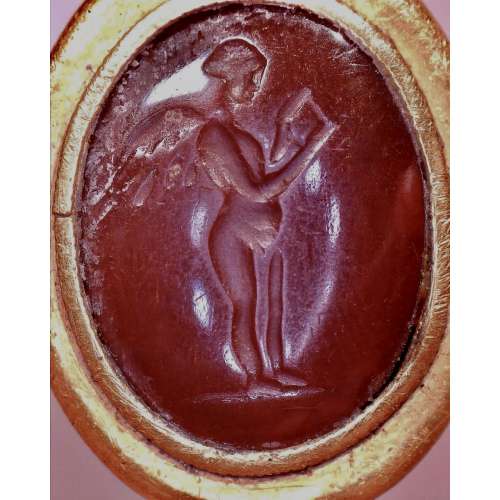 NEWThe intaglio depicts the ancient Greek god Eros looking into a mirror, which he holds in his left hand. Dimensions: 26 x 21 x 20 mm; weight: 11 g. US ring size: 4.25. High-karat gold. Ref.: J. Ogden, A Golden Past: Jewelry from the Ancient World (Catalogue), 1990, p. 10, no. 26 (not seen).
NEWThe intaglio depicts the ancient Greek god Eros looking into a mirror, which he holds in his left hand. Dimensions: 26 x 21 x 20 mm; weight: 11 g. US ring size: 4.25. High-karat gold. Ref.: J. Ogden, A Golden Past: Jewelry from the Ancient World (Catalogue), 1990, p. 10, no. 26 (not seen). -
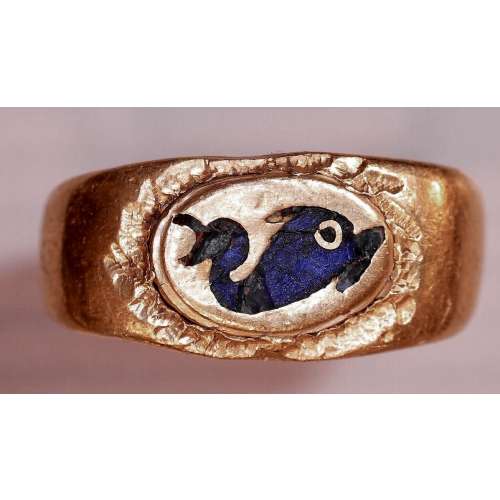 NEWA gold ring with a raised oval face featuring an inlaid blue glass dolphin. Dimensions: 17.7 x 18.8 mm; weight: 4.2 g. US ring size: 4.25. Gold Quality: 96.29% (<23 kt).
NEWA gold ring with a raised oval face featuring an inlaid blue glass dolphin. Dimensions: 17.7 x 18.8 mm; weight: 4.2 g. US ring size: 4.25. Gold Quality: 96.29% (<23 kt). -
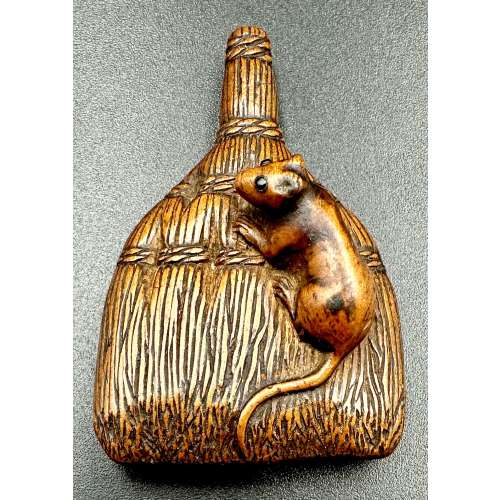 NEWFinely carved as a rat (nezumi) seated on a shuro brush, bound naturalistically with thick bristles. The rodent with a long trailing tail and eyes inlaid in a dark horn. Generously excavated, asymmetrical himotoshi to the underside. According to Merrily Baird (Symbols of Japan, p. 156): …The Japanese do not clearly differentiate between the rat and the mouse, and one word, nezumi [鼠], designates both. …Rat is a messenger of Daikokuten, a deity of grain and vegetation who is one of Japan’s Seven Gods of Good Luck. ...Depictions of the rat are most common in years of the zodiac represented by the animal. Late 18th century. Dimensions: 49 x 33 x 16 mm. Provenance: From the private collection of Armand Basi (Spanish, 1924-2009).
NEWFinely carved as a rat (nezumi) seated on a shuro brush, bound naturalistically with thick bristles. The rodent with a long trailing tail and eyes inlaid in a dark horn. Generously excavated, asymmetrical himotoshi to the underside. According to Merrily Baird (Symbols of Japan, p. 156): …The Japanese do not clearly differentiate between the rat and the mouse, and one word, nezumi [鼠], designates both. …Rat is a messenger of Daikokuten, a deity of grain and vegetation who is one of Japan’s Seven Gods of Good Luck. ...Depictions of the rat are most common in years of the zodiac represented by the animal. Late 18th century. Dimensions: 49 x 33 x 16 mm. Provenance: From the private collection of Armand Basi (Spanish, 1924-2009). -
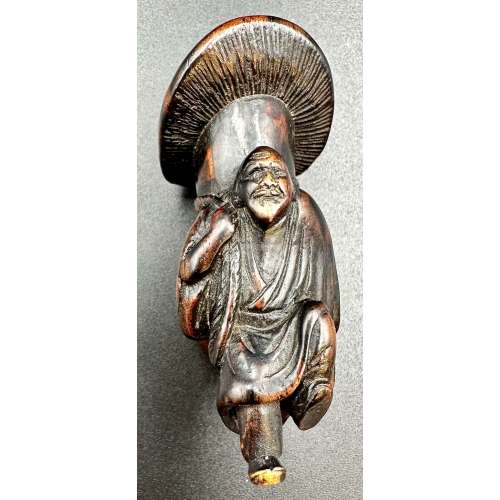 NEW
NEWNetsuke with a design of an old man carrying a giant mushroom on his back. Possibly signed on his left foot. According to Merrily Baird (Symbols of Japan, page. 93): ... This prominent use in the symbol-rich netsuke art form, however, reflects more their sexual symbolism than either their dietary appeal or interesting shapes. Mushrooms in Japan are generally a symbol of fertility, with some flat varieties, like shiitake, being associated with females. In contrast, the matsutake mushroom (Armillaria edodes) is a phallic symbol, as befits its thick, spearlike stem and the fact that it is consumed before cap opens.
Seller's description: "The old man carved walking, with one foot slightly raised, wearing a loose fitted robe and carrying a large long-stemmed mushroom on his back. The wood stained and bearing a fine patina. Himotoshi through the mushroom stem". See VO-0270.2018 for the same subject. Late 18th century. Dimensions: 62 mm tall -
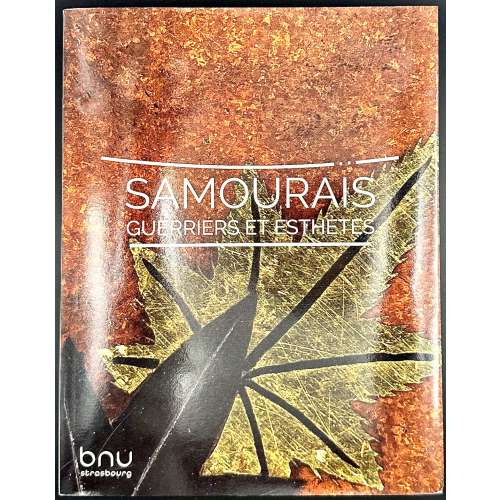 NEWSoftcover, 270 x 210 mm, publisher’s flapped pictorial wrappers, in identical dust jacket, pp. [1-4] 5-189 [3], illustrated throughout with 192 collection items. ISBN 978-2-85923-092-0 Title-page (sanguine): — | SAMOURAÏS | GUERRIERS ET ESTHÈTES | — | CATALOGUE DE L'EXPOSITION | ORGANISÉE A LA BIBLIOTHÉQUE | NATIONALE ET UNIVERSITAIRE | STRASBOURG | 11 MARS – 13 JUILLET 2022 | SOUS LA DIRECTION | DE PATRICK LIEBERMANN, | EMMANUEL MARINE | ET DELPHINE MULARD | ASSISTÉS PAR AGATHE JACQUEMIN | bnu | STRASBOURG || Publisher: Bibliothèque Nationale et Universitaire (Strasbourg) In this collection: TSU-0437.2024
NEWSoftcover, 270 x 210 mm, publisher’s flapped pictorial wrappers, in identical dust jacket, pp. [1-4] 5-189 [3], illustrated throughout with 192 collection items. ISBN 978-2-85923-092-0 Title-page (sanguine): — | SAMOURAÏS | GUERRIERS ET ESTHÈTES | — | CATALOGUE DE L'EXPOSITION | ORGANISÉE A LA BIBLIOTHÉQUE | NATIONALE ET UNIVERSITAIRE | STRASBOURG | 11 MARS – 13 JUILLET 2022 | SOUS LA DIRECTION | DE PATRICK LIEBERMANN, | EMMANUEL MARINE | ET DELPHINE MULARD | ASSISTÉS PAR AGATHE JACQUEMIN | bnu | STRASBOURG || Publisher: Bibliothèque Nationale et Universitaire (Strasbourg) In this collection: TSU-0437.2024
 Contributors Collective:
Emmanuel Marine
Delphine Mulard
Patrick Liebermann
Agathe Jacquemin
Contributors Collective:
Emmanuel Marine
Delphine Mulard
Patrick Liebermann
Agathe Jacquemin -
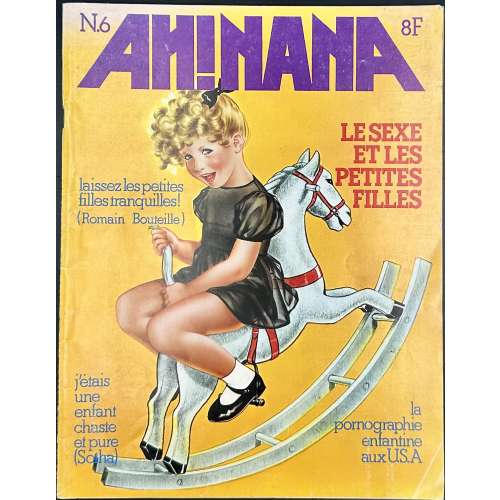 NEWSoftcover, 270 x 210 mm, trimestrial comics magazine AH!NANA published by Les Humanoïdes Associés in Paris from October 1976 to September 1978, running issues 1 to 9. This is issue № 6, printed in 1977, 68 pp., incl. covers in colour by Liz Bijl. Authors/Artists include: Nicole Claveloux, Chantal Montellier, Marie-Noëlle Pichard, Shary Flenniken, Trina Robbins, Cécilia Capuana, and Marianne Leconte.
NEWSoftcover, 270 x 210 mm, trimestrial comics magazine AH!NANA published by Les Humanoïdes Associés in Paris from October 1976 to September 1978, running issues 1 to 9. This is issue № 6, printed in 1977, 68 pp., incl. covers in colour by Liz Bijl. Authors/Artists include: Nicole Claveloux, Chantal Montellier, Marie-Noëlle Pichard, Shary Flenniken, Trina Robbins, Cécilia Capuana, and Marianne Leconte. -
 NEWThin plate iron tsuba of round form with a military commander's fan (gunbai) design in openwork (sukashi); Ko-tosho school. Kamakura period (1185 – 1333), 13th to early 14th century (according to Nakamura Tessei). Dimensions: 91.2 x 89.5 mm, thickness: 1.5-2.5 mm. Provenance: Patrick Liebermann Collection. Reproduced in the exhibition catalogue Samurai. Guerriers et esthètes, BNU, Strasbourg, March 11 – July 13, 2022, №045, p.91 and in Patrick Liebermann, Tsuba. Itinéraires d'une collection, 2016, №72, p.111. Reference: a similar tsuba reproduced in LIB-3304.2024 (see below) and in this collection TSU-0332.2017 (provenance Sasano Masayuki).
NEWThin plate iron tsuba of round form with a military commander's fan (gunbai) design in openwork (sukashi); Ko-tosho school. Kamakura period (1185 – 1333), 13th to early 14th century (according to Nakamura Tessei). Dimensions: 91.2 x 89.5 mm, thickness: 1.5-2.5 mm. Provenance: Patrick Liebermann Collection. Reproduced in the exhibition catalogue Samurai. Guerriers et esthètes, BNU, Strasbourg, March 11 – July 13, 2022, №045, p.91 and in Patrick Liebermann, Tsuba. Itinéraires d'une collection, 2016, №72, p.111. Reference: a similar tsuba reproduced in LIB-3304.2024 (see below) and in this collection TSU-0332.2017 (provenance Sasano Masayuki).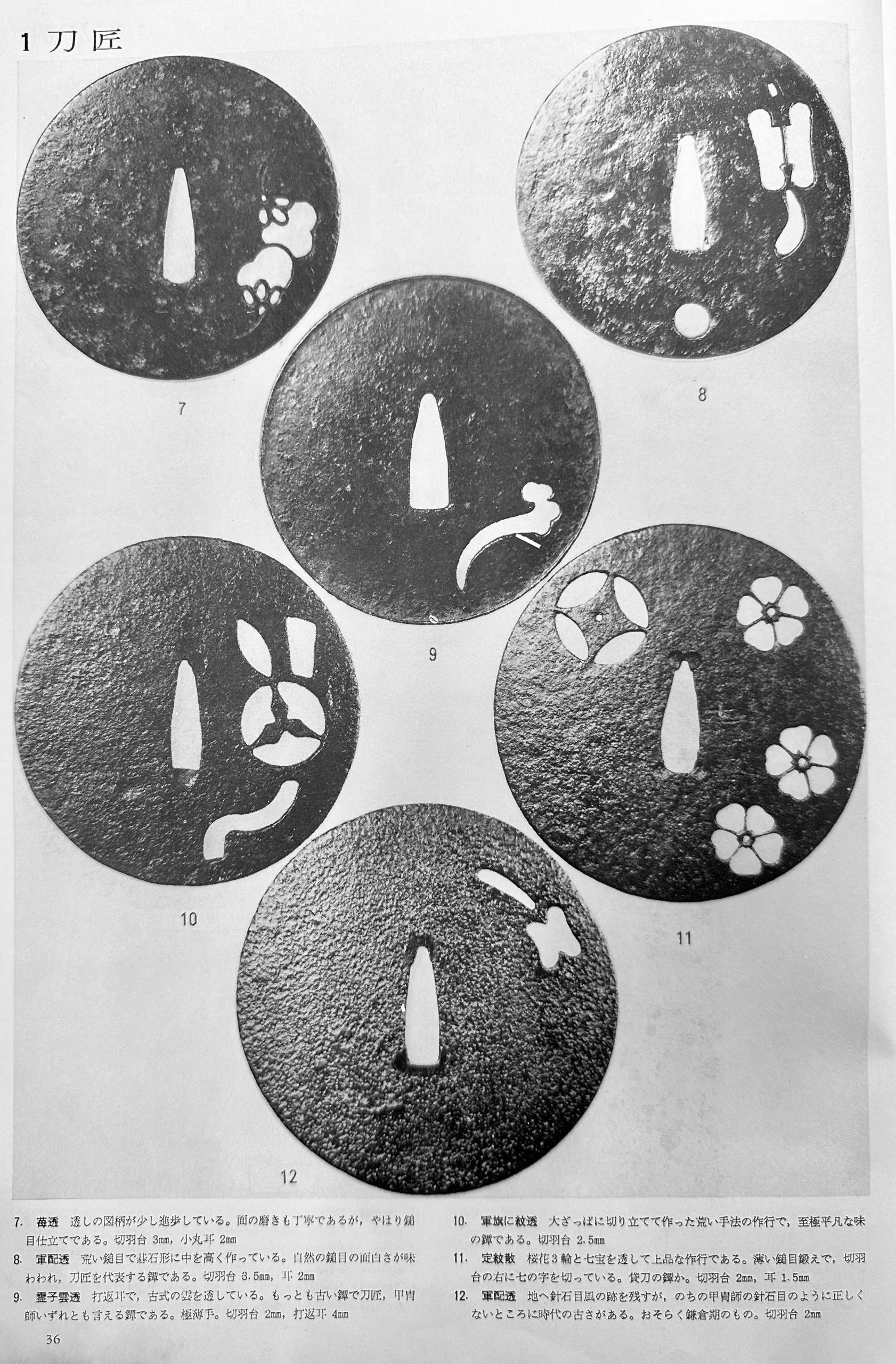
Tsuba Collection (Tsuba shūsei, 鐔集成) by Nakamura Tessei (中村鐵青), p.36, fig. 12.
-
 NEW
NEWLarge iron tsuba of mokko form with the openwork (sukashi) design, described by some as rotten leaves swirling in the wind and boar eyes (inome, 猪目, heart-shaped elements); round rim (maru-mimi); no hitsu-ana; pronounced iron bones (tekkotsu); chocolate patina.
Signed to the left of nakaga-ana: Yamakichibei (山吉兵へ). Attributed to the First Generation (Shodai) master.
Dimensions: 90 x 82 mm, thickness 3.7 mm at centre, 4.9 mm at rim. Weight: 142 gReferences: similar handguards demonstrated at Yasukazu's Owari to Mikawa no tankō №176 and Kajima's Tsuba no Bi №28.
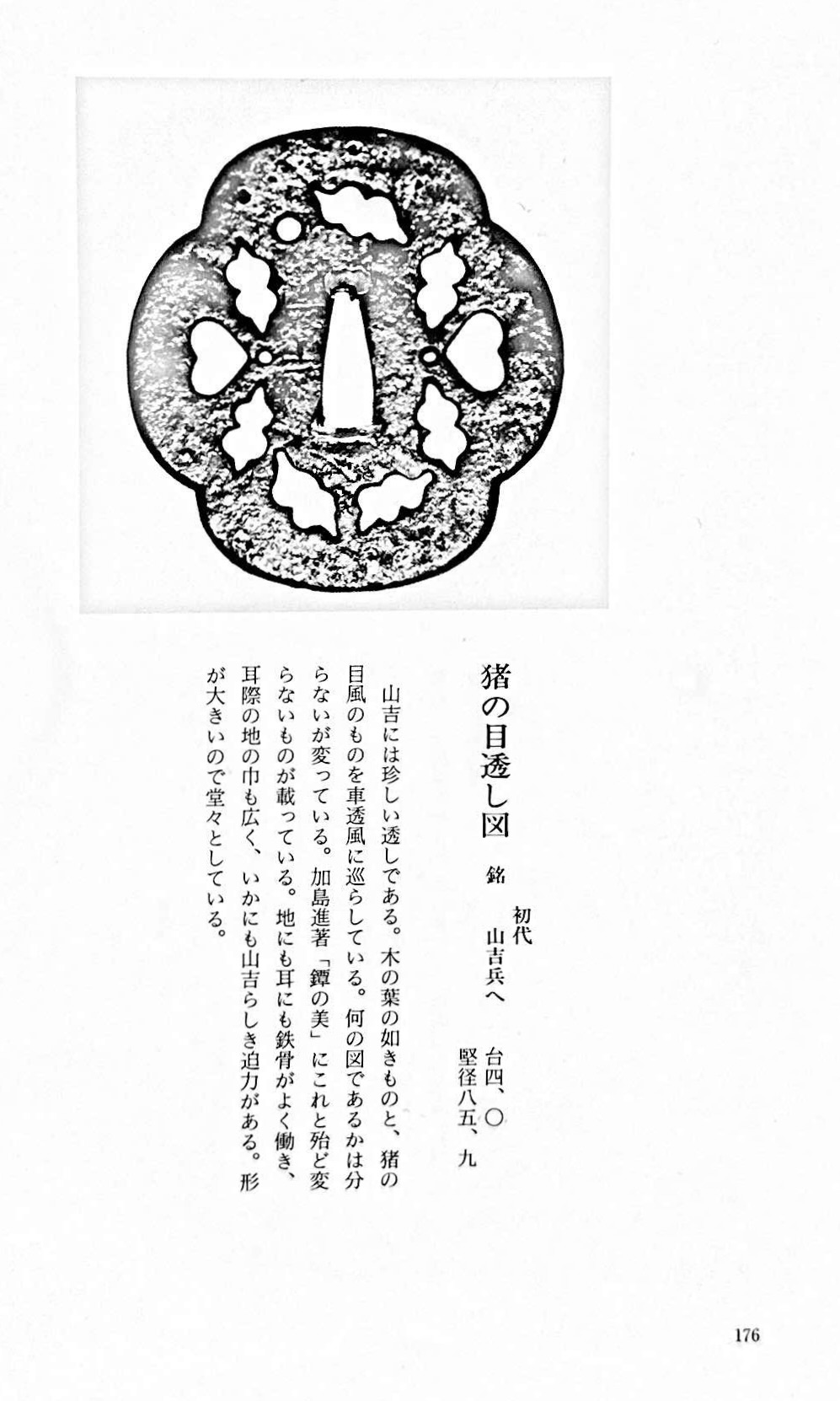
Owari to Mikawa no tankō №176
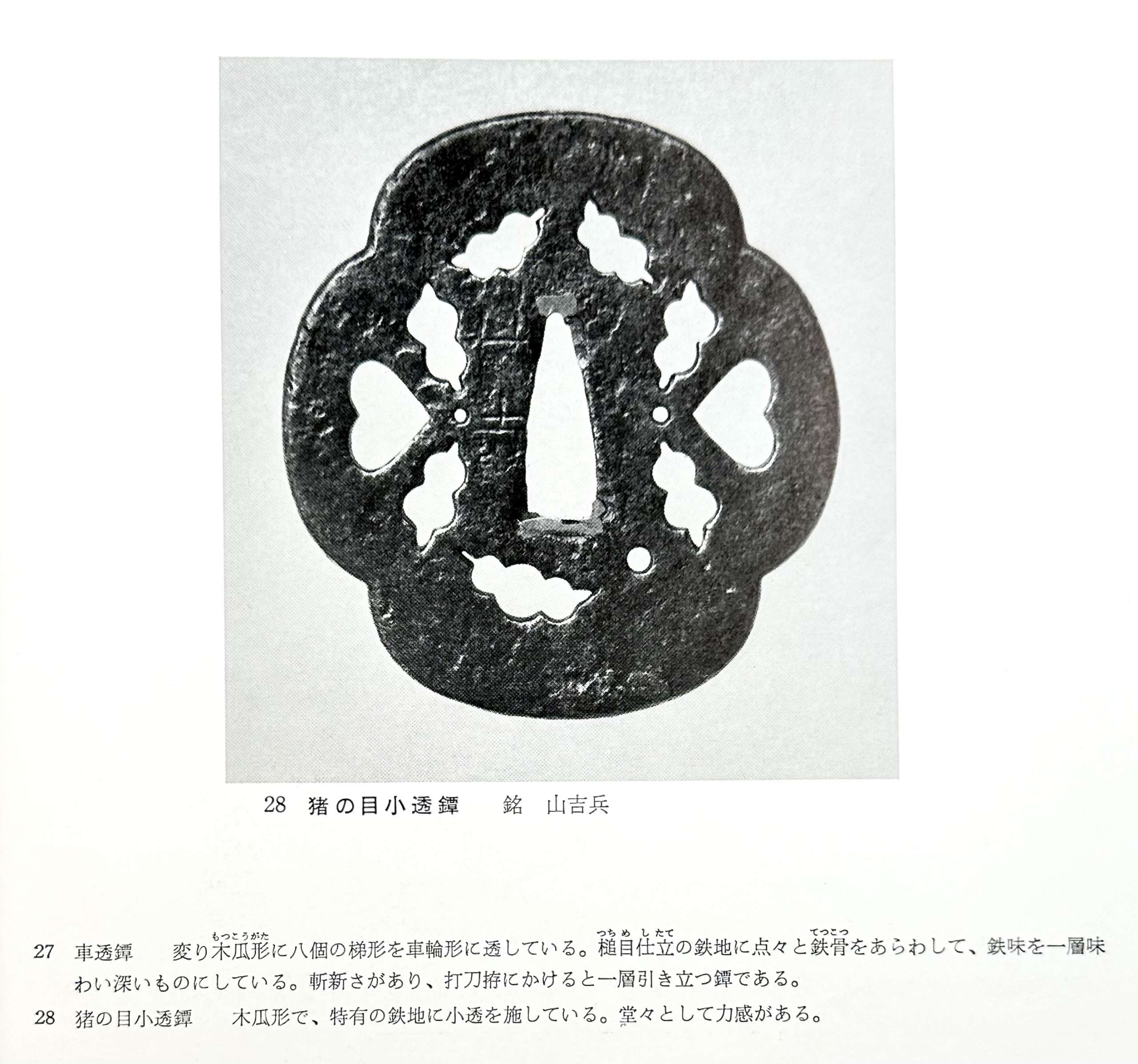
Tsuba no Bi №28
-
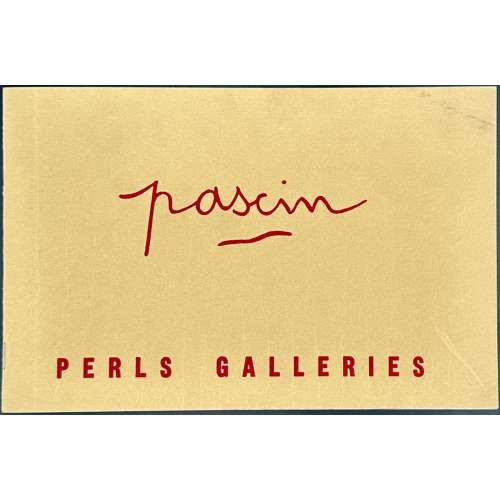 Four exhibition catalogues at Perls Galleries in NYC, coloured stiff laid paper wrappers, colour lettering, staples, b/w plates: September 22 - October 25, 1952, 8 pp; November 14 - December 24, 1955, 12 pp.; “The Nude” January 5 - February 7, 1959. 16 pp.; Portraits and Models November 20 - December 29, 1962, 12 pp. Size: 155 x 240 mm each.
Four exhibition catalogues at Perls Galleries in NYC, coloured stiff laid paper wrappers, colour lettering, staples, b/w plates: September 22 - October 25, 1952, 8 pp; November 14 - December 24, 1955, 12 pp.; “The Nude” January 5 - February 7, 1959. 16 pp.; Portraits and Models November 20 - December 29, 1962, 12 pp. Size: 155 x 240 mm each. -
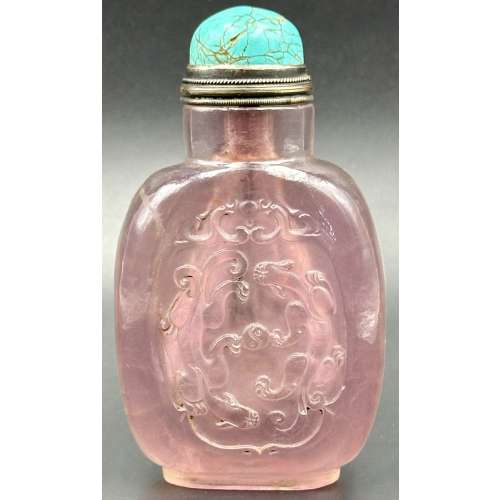 Rose quartz snuff bottle of rounded rectangular form on raised foot with round neck, carved in relief with a double dragon in a cartouche; round turquoise stopper with silver collar.
Rose quartz snuff bottle of rounded rectangular form on raised foot with round neck, carved in relief with a double dragon in a cartouche; round turquoise stopper with silver collar.The Eastern dragon is not the gruesome monster of medieval imagination, but the genius of strength and goodness. He is the spirit of change, therefore of life itself. Hidden in the caverns of inaccessible mountains, or coiled in the unfathomed depth of the sea, he awaits the time when he slowly rouses himself into activity. He unfolds himself in the storm clouds; he washes his mane in the blackness of the seething whirlpools. His claws are in the fork of the lightning, his scales begin to glisten in the bark of rain-swept pine trees. His voice is heard in the hurricane, which, scattering the withered leaves of the forest, a dragon quickens a new spring [C. A. S. Williams. Chinese Symbolism and Art Motifs / 3rd Revised Edition. — Rutland, Vermont & Tokyo, Japan: Charles E. Tuttle Company, 1993].
The Qing dynasty (1644–1911). Mid-19th century. Dimensions: H90 x W52 x D30 mm -
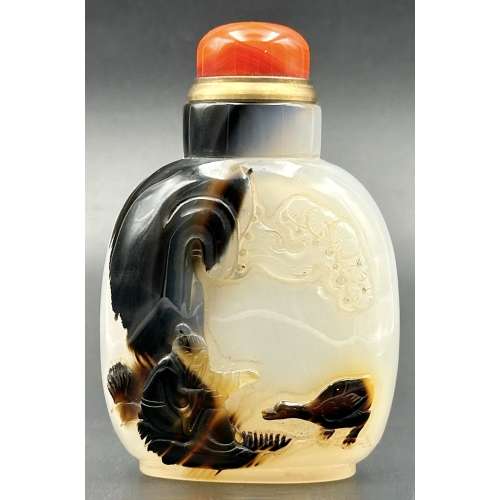 Agate snuff bottle of rounded rectangular form on raised foot with round neck, cream body with dark brown inclusion, carved in relief with a sage seated under a wooded rock, and a duck; round red agate stopper with brass collar. Late 18th or 19th century. The Qing dynasty (1644–1911). Dimensions: H72 x W48 x D28 mm
Agate snuff bottle of rounded rectangular form on raised foot with round neck, cream body with dark brown inclusion, carved in relief with a sage seated under a wooded rock, and a duck; round red agate stopper with brass collar. Late 18th or 19th century. The Qing dynasty (1644–1911). Dimensions: H72 x W48 x D28 mm -
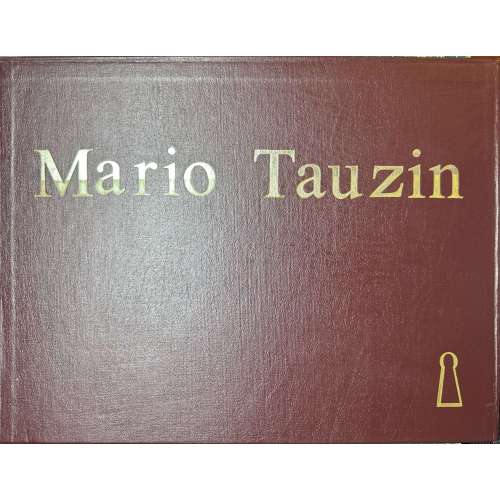 Set of 30 lithographic plates printed on watermarked Van Gelder Simili Japon wove paper, loose in two rexine-backed stiff paper wrappers, 15 in each, together in rexine portfolio with gilt lettering and keyhole on front cover. According to the seller, these are facsimiles of prints/ drawings by Mario Tauzin. Scenes from the series 'Interdit aux adultes'. No publisher indicated; printed in about 1950—a limited edition. Six of these designs used to illustrate 'Bonne à tout faire' were published by Éric Losfeld in the late 1950s (LIB-3293.2024). Dimensions: sheet 320 x 420 mm; album 330 x 430 mm. Contributor: Mario Tauzin (French, 1909 – 1979) — artist
Set of 30 lithographic plates printed on watermarked Van Gelder Simili Japon wove paper, loose in two rexine-backed stiff paper wrappers, 15 in each, together in rexine portfolio with gilt lettering and keyhole on front cover. According to the seller, these are facsimiles of prints/ drawings by Mario Tauzin. Scenes from the series 'Interdit aux adultes'. No publisher indicated; printed in about 1950—a limited edition. Six of these designs used to illustrate 'Bonne à tout faire' were published by Éric Losfeld in the late 1950s (LIB-3293.2024). Dimensions: sheet 320 x 420 mm; album 330 x 430 mm. Contributor: Mario Tauzin (French, 1909 – 1979) — artist -
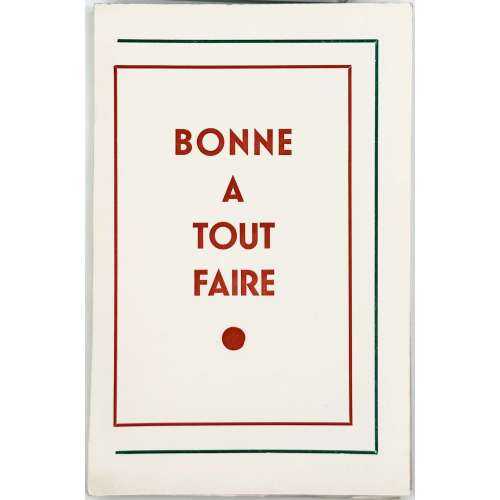 A softcover volume 18.7 x 12.1 cm, in publisher’s cream wrappers, red lettering in red and green frames to front cover, in glassine dustwrapper, uncut, untrimmed, collated in 8vo: 1-98 104, pp. [1-8] 9-151 [152 blank], plus 6 illustrations reproduced in drypoint after Mario Tauzin's lithographs from the album 'Interdit aux adultes' (see SVE-0547.2024). Front cover : BONNE | A | TOUT | FAIRE Title-page : BONNE | A | TOUT | FAIRE Stated limited edition of 900, strictly for subscribers. According to J.-P. Dutel III 1108 (p.66): published by Éric Losfeld in the late 1950s. Bonne à tout faire is a French idiom = maid-of-all-work Éric Losfeld (Belgian-French, 1922 – 1979) — publisher Mario Tauzin (French, 1909 – 1979) — artist
A softcover volume 18.7 x 12.1 cm, in publisher’s cream wrappers, red lettering in red and green frames to front cover, in glassine dustwrapper, uncut, untrimmed, collated in 8vo: 1-98 104, pp. [1-8] 9-151 [152 blank], plus 6 illustrations reproduced in drypoint after Mario Tauzin's lithographs from the album 'Interdit aux adultes' (see SVE-0547.2024). Front cover : BONNE | A | TOUT | FAIRE Title-page : BONNE | A | TOUT | FAIRE Stated limited edition of 900, strictly for subscribers. According to J.-P. Dutel III 1108 (p.66): published by Éric Losfeld in the late 1950s. Bonne à tout faire is a French idiom = maid-of-all-work Éric Losfeld (Belgian-French, 1922 – 1979) — publisher Mario Tauzin (French, 1909 – 1979) — artist -
 Iron tsuba of slightly elongated round form (nagamaru-gata) pierced on top and in the bottom (ko-sukashi) with simplified Genji-kō (incense game symbol) and two petals of bellflower; openings, seppa-dai, and plate along the rim are outlined with brass wire, kozuka-ana outlined with scalloped brass wire, missing on the front; kogai-ana pierced later. The plate is slightly concave with traces of lacquer, decorated in brass (suemon-zōgan) with tendrils, bellflowers, and Genji characters, and with brass dots (ten-zogan), many of which are missing. Measurements: Height 77.5 mm; Width 75.5 mm; thickness at seppa-dai 2.4 mm, at rim 3.2 mm. Time: Late Muromachi (1514 – 1573) or earlier.
Iron tsuba of slightly elongated round form (nagamaru-gata) pierced on top and in the bottom (ko-sukashi) with simplified Genji-kō (incense game symbol) and two petals of bellflower; openings, seppa-dai, and plate along the rim are outlined with brass wire, kozuka-ana outlined with scalloped brass wire, missing on the front; kogai-ana pierced later. The plate is slightly concave with traces of lacquer, decorated in brass (suemon-zōgan) with tendrils, bellflowers, and Genji characters, and with brass dots (ten-zogan), many of which are missing. Measurements: Height 77.5 mm; Width 75.5 mm; thickness at seppa-dai 2.4 mm, at rim 3.2 mm. Time: Late Muromachi (1514 – 1573) or earlier. -

Iron tsuba of round form with one hitsu ana; centre of the plate outlined with the inlaid circular brass wire broke by a circular opening 7 mm in diameter located between 4 and 5 o’clock of the plate and in its turn outlined with brass wire. Extraneous to the central wire, the plate is decorated with four rows of brass dots (ten-zogan). A few dots are missing. In a custom kiri wood box. The meaning of the emblem is probably either the sun or the moon.
Ōnin school. Unsigned.
Mid Muromachi period, middle of the 15th century.
Dimensions: diameter 88 mm; thickness 3.3 mm.
-
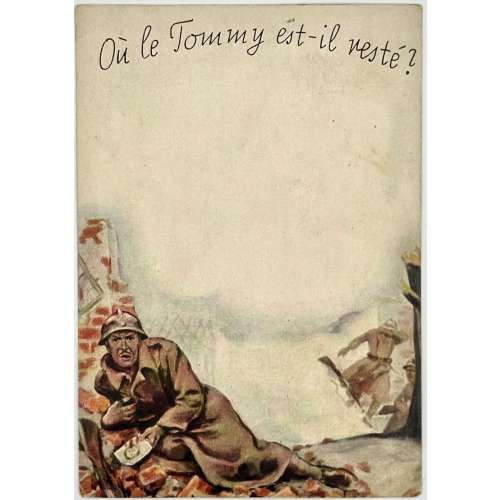 One of a series of six anti-allies propaganda cards, printed in colour, inscribed Ou le Tommy est-il resté? (Where did Tommy stay?), where Tommy is slang for a common soldier in the British Army. The postcards visibly depict French soldiers who fight and die at the western front, while the covert watermark image shows a British military having fun in a bordello. Those cards were printed in the Third Reich for France and dropped from aeroplanes to motivate French soldiers to fight against the British. Size: 149 x 104 mm
One of a series of six anti-allies propaganda cards, printed in colour, inscribed Ou le Tommy est-il resté? (Where did Tommy stay?), where Tommy is slang for a common soldier in the British Army. The postcards visibly depict French soldiers who fight and die at the western front, while the covert watermark image shows a British military having fun in a bordello. Those cards were printed in the Third Reich for France and dropped from aeroplanes to motivate French soldiers to fight against the British. Size: 149 x 104 mm -
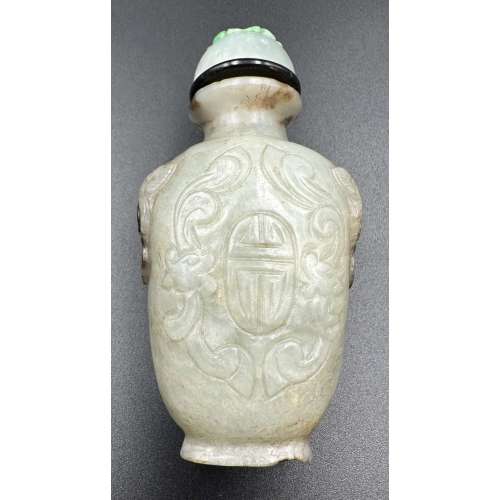 Jadeite snuff bottle carved with shou character and foo dog handles, with a black collar and jadeite stopper carved with a blossom design. Late 19th century. Dimensions: H74 x W39 x D26 mm
Jadeite snuff bottle carved with shou character and foo dog handles, with a black collar and jadeite stopper carved with a blossom design. Late 19th century. Dimensions: H74 x W39 x D26 mm -
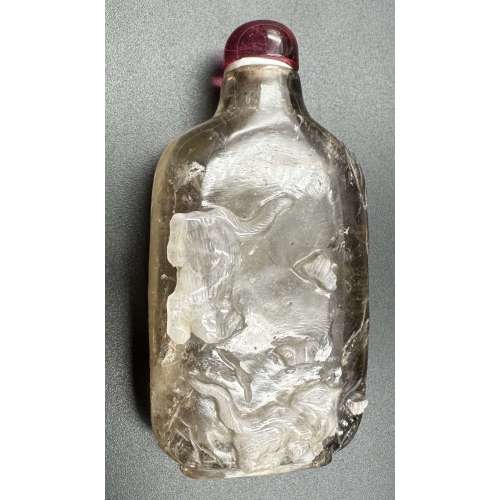 Snuff bottle made of smoky quartz with white skin carved with cats hunting butterflies design; cherry quartz stopper. Late 19th century. Dimensions: H70 x W36 x D17 mm
Snuff bottle made of smoky quartz with white skin carved with cats hunting butterflies design; cherry quartz stopper. Late 19th century. Dimensions: H70 x W36 x D17 mm -
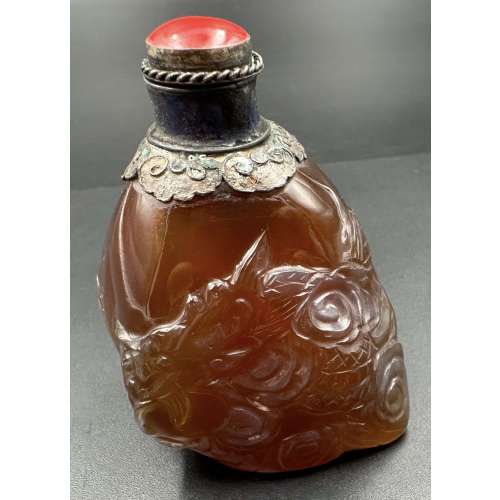 Agate snuff bottle carved with a dragon in clouds design; tin-mounted lapis lazuli collar with red coral stopper. Late 19th century. Dimensions: H56 x W52 x D34 mm.
Agate snuff bottle carved with a dragon in clouds design; tin-mounted lapis lazuli collar with red coral stopper. Late 19th century. Dimensions: H56 x W52 x D34 mm. -
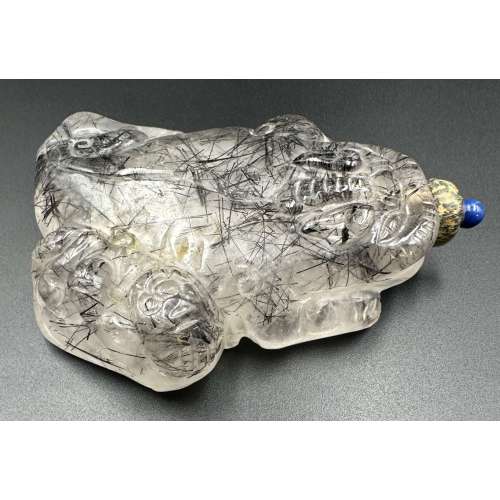 Snuff bottle in the form of Fo (or Fu) dog (lion-dog) guarding a cub carved of tourmalinated quartz with lapis lazuli and serpentine stopper. Late 19th century. Dimensions: L81 x W59 x H19 mm.
Snuff bottle in the form of Fo (or Fu) dog (lion-dog) guarding a cub carved of tourmalinated quartz with lapis lazuli and serpentine stopper. Late 19th century. Dimensions: L81 x W59 x H19 mm. -
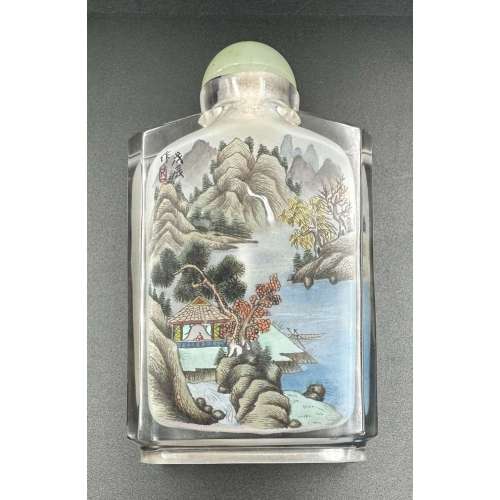 Large inside-painted glass snuff bottle with a mountain landscape design, signed and sealed Wu Chen Zuo, with a serpentine stopper. Mid-20th century. Dimensions: H105 x W61 x D27 mm.
Large inside-painted glass snuff bottle with a mountain landscape design, signed and sealed Wu Chen Zuo, with a serpentine stopper. Mid-20th century. Dimensions: H105 x W61 x D27 mm. -
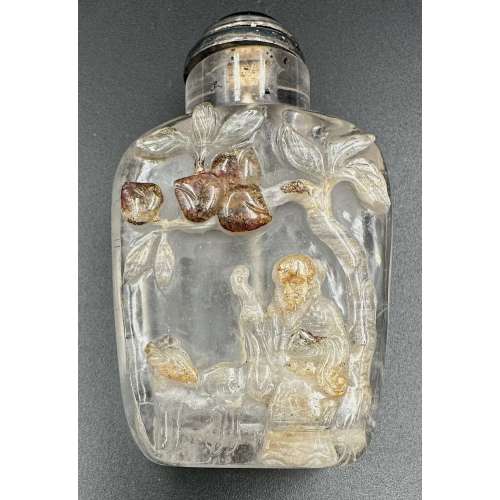 Snuff bottle made of rock crystal with brown skin carved with a sage and a deer under the peach tree on one side and a cuckoo on a plum tree on the other, with a chrysotile stopper and tin collar. Late 19th century. Dimensions: H68 x W40 x D21 mm.
Snuff bottle made of rock crystal with brown skin carved with a sage and a deer under the peach tree on one side and a cuckoo on a plum tree on the other, with a chrysotile stopper and tin collar. Late 19th century. Dimensions: H68 x W40 x D21 mm. -
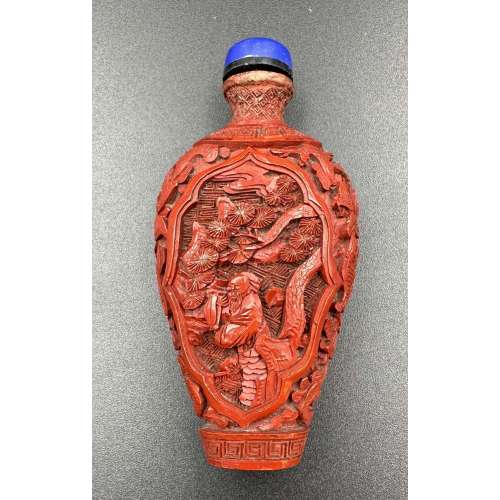 Cinnabar lacquer snuff bottle carved in low relief with a scholar under a pine tree and another under a maple, with lapis lazuli stopper and black collar. Early 20th century Dimansions: H77 x W36 x D19 mm.
Cinnabar lacquer snuff bottle carved in low relief with a scholar under a pine tree and another under a maple, with lapis lazuli stopper and black collar. Early 20th century Dimansions: H77 x W36 x D19 mm. -
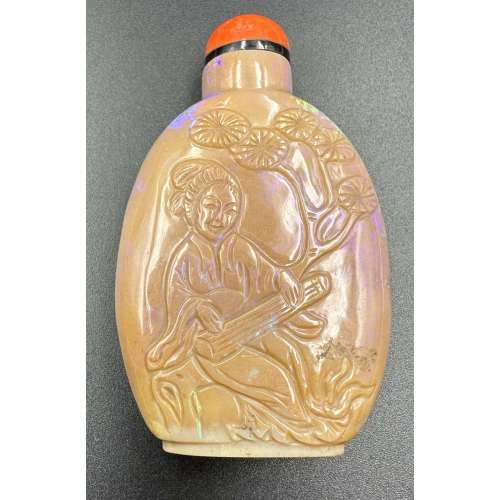 Opal jasper snuff bottle carved in low relief with a beauty playing Guqin under a pine tree and another on the veranda with a folding fan; bamboo, pine, and plum (the three friends of winter); carnelian agate stopper and black collar. Mid-20th century Dimensions: H67 x W41 x D15 mm
Opal jasper snuff bottle carved in low relief with a beauty playing Guqin under a pine tree and another on the veranda with a folding fan; bamboo, pine, and plum (the three friends of winter); carnelian agate stopper and black collar. Mid-20th century Dimensions: H67 x W41 x D15 mm -
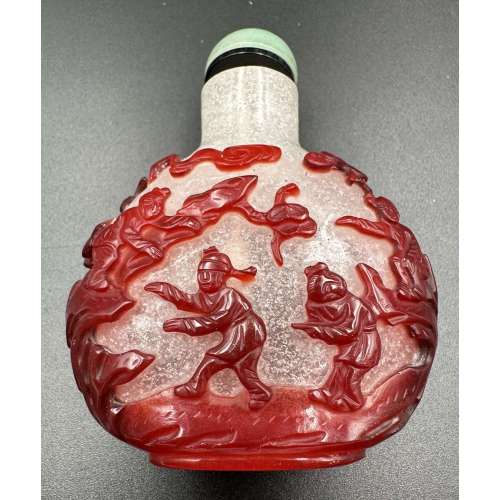 Overlay of red glass on snowflake glass snuff bottle, carved in relief with seven children playing in a landscape with rocks and trees, with aventurine stopper and black collar. Late 19th century Dimensions: H72 x W56 x D30 mm
Overlay of red glass on snowflake glass snuff bottle, carved in relief with seven children playing in a landscape with rocks and trees, with aventurine stopper and black collar. Late 19th century Dimensions: H72 x W56 x D30 mm -
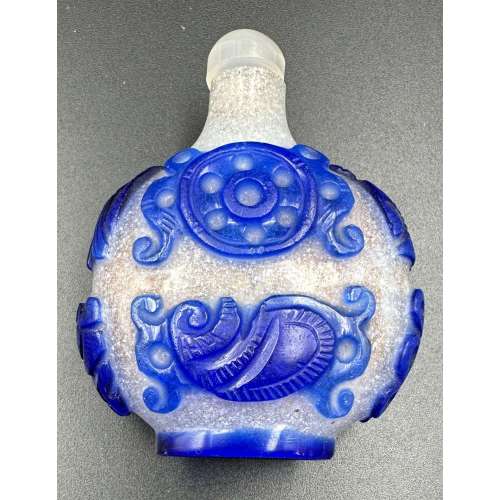 Overlay of blue glass on snowflake glass snuff bottle, carved in relief with eight Buddhist treasures, with a pink glass stopper. Mid-20th century Dimensions: H66 x W50 x D25 mm
Overlay of blue glass on snowflake glass snuff bottle, carved in relief with eight Buddhist treasures, with a pink glass stopper. Mid-20th century Dimensions: H66 x W50 x D25 mm -
 Hardcover, light grey cloth with brown lettering and two-colour vignette in the central panel, lettering to spine, 15 woodcut headpieces to each book and 5 full-page two-colour woodcuts by Leonid Feinberg (1896-1980). Size: 25.5 x 18.5 cm; collation: 8vo. Frontispiece (grey and black): P. OVIDII NASONIS | METAMORPHOSEON | LIBRI | {XV in frame} | ACADEMIA || Title-page (grey and black): П. ОВИДИЙ HAЗOH | МЕТАМОРФОЗЫ | ПЕРЕВОД | С. В. ШЕРВИНСКОГО | СТАТЬЯ О ТВОРЧЕСТВЕ ОВИДИЯ | А. И. БЕЛЕЦКОГО | РЕДАКЦИЯ И КОММЕНТАРИИ | Ф. А. ПЕТРОВСКОГО | {vignette / 1937} | ACADEMIA || Imprint: Переплет, иллюстрации, заставки | и титульные страницы по рисункам | Л. Е. Фейнберга || Published: II-1937; print-run: 5,300 copies. Pp.: [i-vi] vii-xxix [xxx] [2] 3-358 [8], total 396 pp: i/ii publisher’s device/blank, iii/iv blank/frontis., v/vi t.p./imprint, vii-xxx text preface, 1/2 h.t./blank, 3-330 text,331/2 h.t./blank, 333/59 commentary, 360 summary, 361/2 table of contents/blank, 363/4 errata/blank, 365/6 colophon/blank. Collation: ffl, i8 ii7 1-228 237, ffl, total 198 leaves plus 5 full-page two-colour woodcuts extraneous to collation. Publius Ovidius Naso [Ovid] (Roman, 43 BC – AD 17/18) – Author. Белецкий, Александр Иванович (Ukrainian, 1884 – 1961) – Author (foreword) Петровский, Фёдор Александрович (Russian,1890 – 1978) – Author (editor) Шервинский, Сергей Васильевич (Russian, 1892 – 1991) – Translator Фейнберг, Леонид Евгеньевич (Jewish-Russian, 1896 – 1980) – Artist References: [LIB-2679.2021] Ovid’s Metamorphoses in Fifteen Books / Translated by the Most Eminent Hands. — London: Jacob Tonson, 1717. [LIB-2586.2020] Ovid’s Metamorphoses in Latin and English (2 vols.) — Amsterdam: Wetstein & Smith, 1732.
Hardcover, light grey cloth with brown lettering and two-colour vignette in the central panel, lettering to spine, 15 woodcut headpieces to each book and 5 full-page two-colour woodcuts by Leonid Feinberg (1896-1980). Size: 25.5 x 18.5 cm; collation: 8vo. Frontispiece (grey and black): P. OVIDII NASONIS | METAMORPHOSEON | LIBRI | {XV in frame} | ACADEMIA || Title-page (grey and black): П. ОВИДИЙ HAЗOH | МЕТАМОРФОЗЫ | ПЕРЕВОД | С. В. ШЕРВИНСКОГО | СТАТЬЯ О ТВОРЧЕСТВЕ ОВИДИЯ | А. И. БЕЛЕЦКОГО | РЕДАКЦИЯ И КОММЕНТАРИИ | Ф. А. ПЕТРОВСКОГО | {vignette / 1937} | ACADEMIA || Imprint: Переплет, иллюстрации, заставки | и титульные страницы по рисункам | Л. Е. Фейнберга || Published: II-1937; print-run: 5,300 copies. Pp.: [i-vi] vii-xxix [xxx] [2] 3-358 [8], total 396 pp: i/ii publisher’s device/blank, iii/iv blank/frontis., v/vi t.p./imprint, vii-xxx text preface, 1/2 h.t./blank, 3-330 text,331/2 h.t./blank, 333/59 commentary, 360 summary, 361/2 table of contents/blank, 363/4 errata/blank, 365/6 colophon/blank. Collation: ffl, i8 ii7 1-228 237, ffl, total 198 leaves plus 5 full-page two-colour woodcuts extraneous to collation. Publius Ovidius Naso [Ovid] (Roman, 43 BC – AD 17/18) – Author. Белецкий, Александр Иванович (Ukrainian, 1884 – 1961) – Author (foreword) Петровский, Фёдор Александрович (Russian,1890 – 1978) – Author (editor) Шервинский, Сергей Васильевич (Russian, 1892 – 1991) – Translator Фейнберг, Леонид Евгеньевич (Jewish-Russian, 1896 – 1980) – Artist References: [LIB-2679.2021] Ovid’s Metamorphoses in Fifteen Books / Translated by the Most Eminent Hands. — London: Jacob Tonson, 1717. [LIB-2586.2020] Ovid’s Metamorphoses in Latin and English (2 vols.) — Amsterdam: Wetstein & Smith, 1732. -
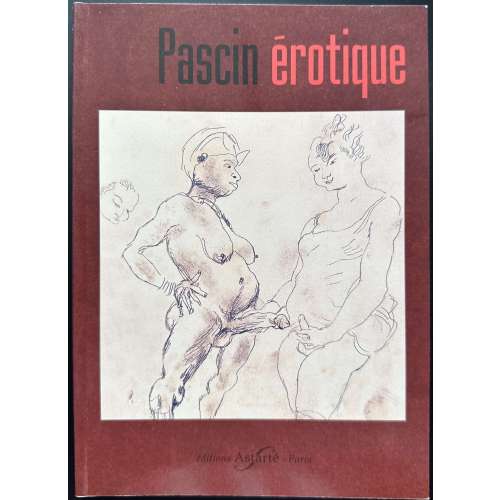 Catalogue raisonné of Pascin's erotic drawings. Softcover, 21 x 15 cm, burgundy gloss pictorial paperback with lettering and vignettes, pp.: [1-3] 4-102 [2], illustrated throughout. Limited edition of 1,000 copies. Title-page: Pascin érotique | {round vignette} | éditions Astarté - Paris || Contributors: Alexandre Dupouy (French) Pascin, Jules [Pincas, Julius Mordecai] (French-Jewish, 1885 – 1930)
Catalogue raisonné of Pascin's erotic drawings. Softcover, 21 x 15 cm, burgundy gloss pictorial paperback with lettering and vignettes, pp.: [1-3] 4-102 [2], illustrated throughout. Limited edition of 1,000 copies. Title-page: Pascin érotique | {round vignette} | éditions Astarté - Paris || Contributors: Alexandre Dupouy (French) Pascin, Jules [Pincas, Julius Mordecai] (French-Jewish, 1885 – 1930) -
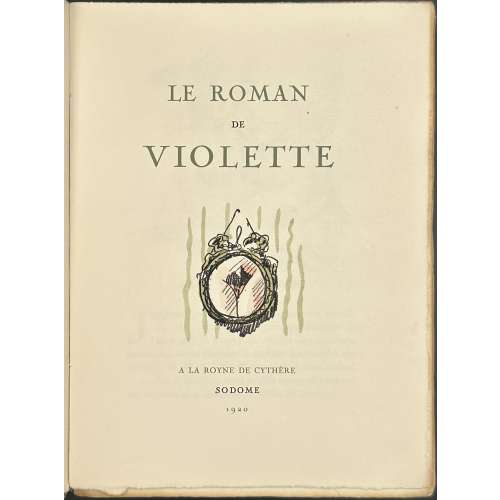 Softcover volume, 19.5 x 14.3 cm, olive French flapped wrappers, glassine dust cover, printed on laid paper (Hollande), outer and bottom margins untrimmed, some pages uncut; pagination: [2] blank, [i-iv] h.t./limit., t.p./blank, v-viii, 1-196 [197] [5], total 212 pages plus frontispiece; head- and tailpieces and in-text stencil-coloured etchings after Chéripoulos. Title-page (olive and black): LE ROMAN | DE | VIOLETTE | {vignette} | A LA ROYNE DE CYTHÈRE | SODOME | 1920 || Limitation: Cet ouvrage, achevé d'imprimer le cinq Janvier Mil Neuf Cent Vingt à trois cents exemplaires dont vingt-cinq exemplaires sur Japon Impérial contenant chacun un dessin original de Chéripoulos, numérotés de un à vingt-cinq; deux cent soixante-quinze exemplaires sur papier de Hollande, numérotés de vingt-six à trois cents; en plus cinq exemplaires de collaborateurs marqués de A à E. Le présent exemplaire porte le numéro 72. Edition: Printed on the 5th of January 1920 in 305 copies (№№ 1-25 on Japon Impérial, №№ 26-300 on Hollande, A–E for collaborators). Catalogue raisonné: Dutel III № 2339, p. 350. Contributors: Henriette de Mannoury d'Ectot [Henriette Nicolas Le Blanc] (French 1815 – 1899) Charles Auguste Edelmann [Chéripoulos] (French, 1879 – 1950).
Softcover volume, 19.5 x 14.3 cm, olive French flapped wrappers, glassine dust cover, printed on laid paper (Hollande), outer and bottom margins untrimmed, some pages uncut; pagination: [2] blank, [i-iv] h.t./limit., t.p./blank, v-viii, 1-196 [197] [5], total 212 pages plus frontispiece; head- and tailpieces and in-text stencil-coloured etchings after Chéripoulos. Title-page (olive and black): LE ROMAN | DE | VIOLETTE | {vignette} | A LA ROYNE DE CYTHÈRE | SODOME | 1920 || Limitation: Cet ouvrage, achevé d'imprimer le cinq Janvier Mil Neuf Cent Vingt à trois cents exemplaires dont vingt-cinq exemplaires sur Japon Impérial contenant chacun un dessin original de Chéripoulos, numérotés de un à vingt-cinq; deux cent soixante-quinze exemplaires sur papier de Hollande, numérotés de vingt-six à trois cents; en plus cinq exemplaires de collaborateurs marqués de A à E. Le présent exemplaire porte le numéro 72. Edition: Printed on the 5th of January 1920 in 305 copies (№№ 1-25 on Japon Impérial, №№ 26-300 on Hollande, A–E for collaborators). Catalogue raisonné: Dutel III № 2339, p. 350. Contributors: Henriette de Mannoury d'Ectot [Henriette Nicolas Le Blanc] (French 1815 – 1899) Charles Auguste Edelmann [Chéripoulos] (French, 1879 – 1950). -
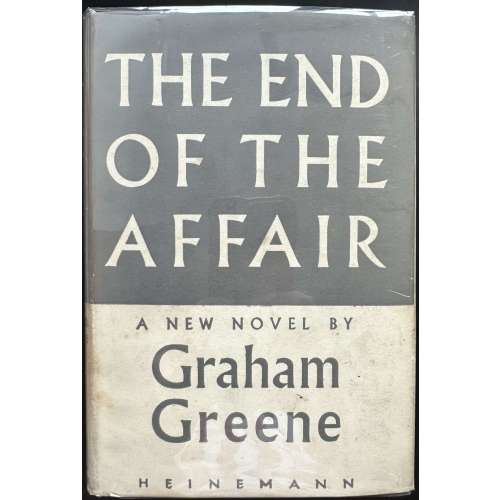 Hardcover volume, 19 x 13 cm, grey cloth with gilt lettering to spine, grey/cream dust jacket lettered throughout, price “10s 6d | NET” unclipped. Covers rubbed, dust jacket has a purple ink stain on the back bottom. Black ink inscription to recto ffl. Collation: a-o8 p10, total 122 leaves; pp.: [6] 1-237 [238]. 1st edition, 1st issue / Great Britain. Title-page: THE END OF THE | AFFAIR | by | GRAHAM GREENE | {publisher’s device} | — | WILLIAM HEINEMANN LTD | MELBOURNE :: LONDON :: TORONTO || Imprint: FIRST PUBLISHED 1951 | PRINTED IN GREAT BRITAIN | AT THE WINDMILL PRESS | KINGSWOOD, SURREY || Dedication: To C. (Catherine Walston, nee Crompton, American, 1925 – 1978) Contributors: Graham Greene (British, 1904 – 1991) William Henry Heinemann (Jewish-British, 1863 – 1920)
Hardcover volume, 19 x 13 cm, grey cloth with gilt lettering to spine, grey/cream dust jacket lettered throughout, price “10s 6d | NET” unclipped. Covers rubbed, dust jacket has a purple ink stain on the back bottom. Black ink inscription to recto ffl. Collation: a-o8 p10, total 122 leaves; pp.: [6] 1-237 [238]. 1st edition, 1st issue / Great Britain. Title-page: THE END OF THE | AFFAIR | by | GRAHAM GREENE | {publisher’s device} | — | WILLIAM HEINEMANN LTD | MELBOURNE :: LONDON :: TORONTO || Imprint: FIRST PUBLISHED 1951 | PRINTED IN GREAT BRITAIN | AT THE WINDMILL PRESS | KINGSWOOD, SURREY || Dedication: To C. (Catherine Walston, nee Crompton, American, 1925 – 1978) Contributors: Graham Greene (British, 1904 – 1991) William Henry Heinemann (Jewish-British, 1863 – 1920) -
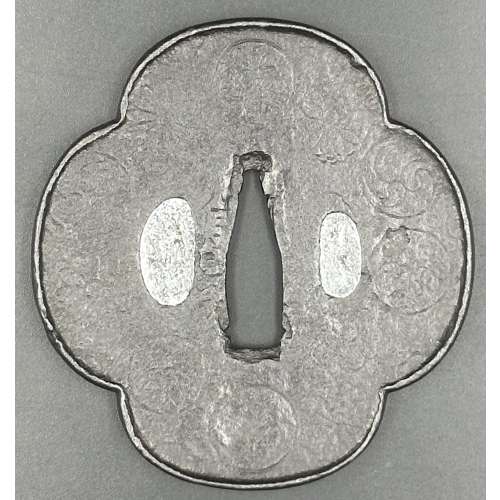 Iron tsuba of mokko form decorated with encircled family crests in low relief carving; niku from 3.0 mm in the centre to 4.0 mm at rim and full 1 mm raised uchikaeshi-mimi. Nobuie [信家] signature (hanare-mei) to the left of nakago-ana; on the reverse, to the right of nakago-ana, the inscription reads “62”, which may be how old the master was at the age of making the tsuba. Pewter or lead plugged hitsuana. In a wooden box, in a custom pouch. Size: H: 80 mm, W: 75, Th(c): 3.1 mm, Th(r): 4.0 mm Weight: 103.5 g
Iron tsuba of mokko form decorated with encircled family crests in low relief carving; niku from 3.0 mm in the centre to 4.0 mm at rim and full 1 mm raised uchikaeshi-mimi. Nobuie [信家] signature (hanare-mei) to the left of nakago-ana; on the reverse, to the right of nakago-ana, the inscription reads “62”, which may be how old the master was at the age of making the tsuba. Pewter or lead plugged hitsuana. In a wooden box, in a custom pouch. Size: H: 80 mm, W: 75, Th(c): 3.1 mm, Th(r): 4.0 mm Weight: 103.5 gSigned: Nobuie [信家] / 62
Probably the work of Shodai Nobuie (c. 1580).
Tokubetsu hozon certificate № 2002993 of the N.B.T.H.K., dated January 15, 2016. NOBUIE TSUBA by Steve Waszak The iron tsuba made by the two early Nobuie masters are regarded as the greatest sword guards ever made across hundreds of years of Japanese history. Only a small handful of other smiths' names are even mentioned in the same breath as that of Nobuie. Despite the well-deserved fame of the Nobuie name, virtually nothing is known with certainty about the lives of the two men who made the pieces carrying this name. They are thought to have been men of Owari Province, with the Nidai Nobuie also spending time in Aki Province at the end of the Momoyama Period. Two Nobuie tsubako are recognized. The man whom most consider to have been the Shodai signed his sword guards with finer and more elegantly inscribed characters than the smith seen by most as the Nidai. The term used to describe the mei of the Shodai is "hanare-mei" or "ga-mei," while that used to characterize the signature of the Nidai is "futoji-mei" or "chikara-mei." These terms refer to the fineness and grace of the Shodai's signature and the relatively more powerfully inscribed characters of the Nidai's. The Shodai is thought to have lived during the Eiroku and Tensho eras in the latter part of the 16th century, while the Nidai's years are considered to have been from Tensho into the Genna era. This locates both smiths well within the Golden Age of tsuba artists -- the Momoyama Period. Nobuie tsuba are esteemed and celebrated for the extraordinary beauty of their iron. The combination of the forging of the metal, the surface treatment by tsuchime and yakite married to powerfully expressive carving, the masterful manipulation of form, mass and shape, and the colour and patina of the iron makes Nobuie sword guards not only unique in the world of tsuba, but the greatest of the great. The sword guard here is a Shodai-made masterwork, done in mokko-gata form, a shape the early Nobuie smiths mastered to a degree unmatched by any others. The expanding of the mass of the tsuba from the seppa-dai to the mimi, increasing by 50% from the centre of the guard to the rim, creates a sense of exploding energy, which is then contained by the uchikaeshi-mimi, yielding a lightning-in-a-bottle effect of captured energy. The hammering the master has employed to finish the surface is subtle and sensitive, achieving a resonant profundity, and the deep blue-black colour -- augmented by a lustrous patina -- leaves the tsuba to positively glow in one's hand. In this piece, Nobuie has used a motif of several kamon, or family crests, each carved only lightly on the surface in a loose ring around the nakago-ana. Due to the shallow depth of this carving, together with the tsuchime finish of the plate, the effect is to leave the kamon with a sort of weathered appearance, recalling the prime aesthetic values of sabi and wabi, which had great circulation in the Tea Culture so ascendant in the Momoyama years. However, the effects of sabi and wabi expressed in the treatment described above are amplified and deepened by the color and patina of the iron, thereby adding yet another aesthetic value -- yuugen -- which is linked with the abiding mystery of the universe and one more — mono no aware — which alludes to the pathos of life's experiences and transitory nature. In short, this Nobuie tsuba joins poetry with power and therein exemplifies the unrivalled brilliance of Nobuie workmanship. -
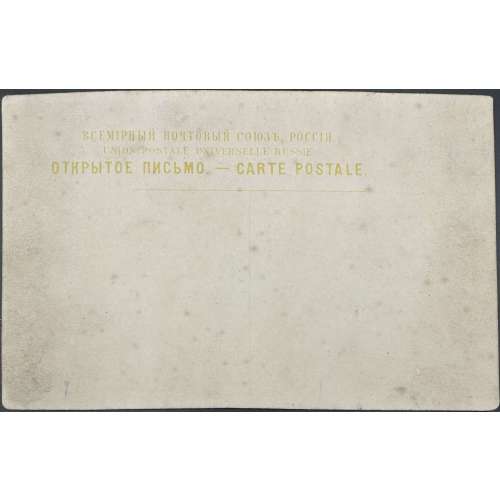 Ten postcards 90 x 140 mm, text in yellow "ВСЕМIРНЫЙ ПОЧТОВЫЙ СОЮЗЪ. РОССIЯ. | UNION POSTALE UNIVERSELLE RUSSIE. | ОТКРЫТОЕ ПИСЬМО. — CARTE POSTALE. || On the reverse, a blue ink woodcut image is printed in the upper left corner, and a blue ink numbered image title is in the bottom centre. Holding the postcard against the backlight reveals a hidden image of an indecent nature (erotic). The use of Latin characters "R" and "N" instead of Russian "Р" and "Н" suggests that the cards were produced in Europe, probably in France. Inscriptions: 1. ПЕRВЫЕ ДNИ; 2. ПОRА ЛЮБВИ; 3. ВЪ ЛЮДИ; 4. КЪ "СВОБОДNОМУ ИСКУССТВУ"; 5. "СВОБОДNЫЙ ТRУДЪ; 6. БЕЗЪ ГОRЯ И ПЕЧАЛИ; 7. NАЗАДЪ КЪ "СВОБОДNОЙ ЛЮБВИ"; 8. ВСЕ ЧТО ОСТАЛОСЬ!; 9. БЕЗЪ КRОВА И ПRИСТАNИЩА; 10. ИЗЪ ЗА ХЛѢБА.
Ten postcards 90 x 140 mm, text in yellow "ВСЕМIРНЫЙ ПОЧТОВЫЙ СОЮЗЪ. РОССIЯ. | UNION POSTALE UNIVERSELLE RUSSIE. | ОТКРЫТОЕ ПИСЬМО. — CARTE POSTALE. || On the reverse, a blue ink woodcut image is printed in the upper left corner, and a blue ink numbered image title is in the bottom centre. Holding the postcard against the backlight reveals a hidden image of an indecent nature (erotic). The use of Latin characters "R" and "N" instead of Russian "Р" and "Н" suggests that the cards were produced in Europe, probably in France. Inscriptions: 1. ПЕRВЫЕ ДNИ; 2. ПОRА ЛЮБВИ; 3. ВЪ ЛЮДИ; 4. КЪ "СВОБОДNОМУ ИСКУССТВУ"; 5. "СВОБОДNЫЙ ТRУДЪ; 6. БЕЗЪ ГОRЯ И ПЕЧАЛИ; 7. NАЗАДЪ КЪ "СВОБОДNОЙ ЛЮБВИ"; 8. ВСЕ ЧТО ОСТАЛОСЬ!; 9. БЕЗЪ КRОВА И ПRИСТАNИЩА; 10. ИЗЪ ЗА ХЛѢБА. -
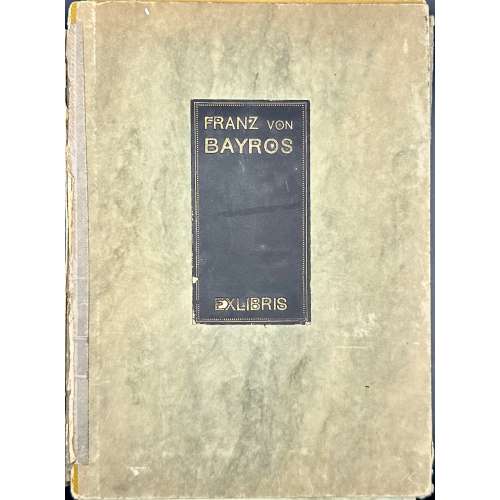 A set of 49 prints, heliogravures and etchings, tipped-in on 285 x 257 mm grey cards, in a green marbled folder with a gilt-lettered black label to the front. No publisher, no place, no year (s.l., s.n., s.d.), printed in circa 1910.
A set of 49 prints, heliogravures and etchings, tipped-in on 285 x 257 mm grey cards, in a green marbled folder with a gilt-lettered black label to the front. No publisher, no place, no year (s.l., s.n., s.d.), printed in circa 1910.- Vlastimil Blažek (Czech, 1878 – 1950): heliogravure, sheet 180 x 137 mm, plate 152 x 114 mm; laid paper, black sepia ink; unsigned.
- Ex libris Gerhard Wunderlich (architect in Dresden): heliogravure, sheet 205 x 150 mm, plate 158 x 115 mm; wove paper, brown sepia ink; inscription: heliogravure, sheet 180 x 137 mm, plate 152 x 114 mm; laid paper, sepia ink; inscription to top “Es ist alles so eng”; signed “F (backwards). Bayros”.
- Ex libris William Lipka: heliogravure, sheet 140 x 125 mm, plate 112 x 98 mm; laid paper, black sepia ink; signature hardly legible.
- Nikolaus Schindler (amateur photographer in Vienna): heliogravure, sheet 142 x 150 mm, plate 110 x 117 mm; laid paper, black sepia ink; unsigned.
- Sussy de Coiquard: heliogravure, sheet 160 x 140 mm, plate 128 x 110 mm; laid paper, black sepia ink; unsigned.
- Illegible, looks like “Vielluer Febréy”: heliogravure, sheet 120 x 109 mm, plate 93 x 85 mm; laid paper, black, sepia ink; signed “F (backwards). Bayros:”.
- Ex libris Erich Liebermann-Rosswiese (Greman-Jewish, 1886 – 1942): heliogravure, sheet 180 x 139 mm, plate 118 x 88 mm; wove paper, black sepia ink; unsigned.
- Ex libris Dr. phil. Rudolf Ludwig: before letters, heliogravure, sheet 150 x 132 mm, plate 120 x 110 mm; laid paper, black sepia ink; unsigned. See [LIB-3258.2023] John Cleland. Die Memoiren der Fanny Hill. — Paphos [i.e. Vienna]: C. W. Stern, 1906.
- Unidentified: before letters, heliogravure, sheet 150 x 115 mm, plate 113 x 88 mm; laid paper, black sepia ink; signed “F. Bayros” in the manuscript. Circumstantial evidence tells that this bookplate belongs to someone A.W.(Artur Wolf). See №22.
- Lulu. Monachia. Gest. v. Ritter Dialekt und Junker Erich: heliogravure, sheet 204 x 152 mm, plate 160 x 118 mm; wove paper, black sepia ink; unsigned. See №20.
- Kellner Jstván: (István): heliogravure, sheet 118 x 100 mm, plate 85 x 70 mm; laid paper, black sepia ink; signed “Franz Bayros” in the script (hardly legible).
- Adyton: heliogravure, sheet 170 x 130 mm, plate 113 x 85 mm; wove paper, black, sepia ink; signed “F (backwards). Bayros”.
- 13.Ex libris George Arthur Buhl (American, 1883 – 1959): heliogravure, sheet 166 x 140 mm, plate 120 x 92 mm; wove paper, black sepia ink; inscription “!I will! | !And I can!”; bust inscribed “T. Carlyle”; signed “F (backwards). Bayros” (hardly legible).
- Ex-Libris Heinrich und Lise Fuhrmann: heliogravure, sheet 165 x 149 mm, plate 120 x 103 mm; wove paper, black sepia ink; signed “F (backward). Bayros”; inscription “So schaff ich am sausenden Webstuhl der Zeit und wirke der Gottheit lebendiges Kleid” (from ‘Faust’ by Goethe).
- Ex libris Gerhard Wunderlich (architect in Dresden): heliogravure, sheet 165 x 137 mm, plate 135 x 105 mm; laid paper, black, sepia ink; signed “F (backwards). Bayros”.
- Ex Libris Walther u. Amelia Fahrenhorst; Walter Fahrenhorst (German, 1871 – 1938): heliogravure, sheet 165 x 140 mm, plate 128 x 95 mm; wove paper, black sepia ink; signed “F. Bayros” in the manuscript. The inscription behind the strings: NITOR (lat. beauty, glamour).
- Ex Libris Margot Lewknecht; heliogravure, sheet 145 x 140 mm, plate 128 x 118 mm; laid paper, black sepia ink; signed “F. Bayros”.
- Ex Libris Walther Heinisch (publisher in Carlsbad); heliogravure, sheet 185 x 145 mm, plate 140 x 110 mm; wove paper, sanguine; male bust with an inscription to the base: “Arnold Boeklin” / Arnold Böcklin (Swiss, 1827 – 1901); inscription: “mit gêru scal man geba infâhan” – a line from Hildebrandslied, the earliest poetic text in German. Unsigned.
- Bookplate with music score GGDBGC; heliogravure, sheet 125 x 135 mm, plate 100 x 110 mm, with monogram «HCJ»; laid paper, brown sepia ink; signed “F. Bayros”.
- Bookplate with inscription: Lulu aus Praga | Gest v. Ritter Dialekt / Monachia / Monachia / und Junker Erich; heliogravure, sheet 182 x 147 mm, plate 160 x 120 mm, image 122 x 105 mm; wove paper, bluish-black sepia ink; unsigned. See №10.
- Bookplate, no inscription; heliogravure, laid paper, sepia ink, sheet 148 x 127 mm, image 84 x 79 mm; signed F. Bayros in the manuscript beneath the image.
- Ex libris Artur Wolf: heliogravure, laid paper, sepia ink, sheet 170 x 150 mm, image 120 x 105 mm; signed F. Bayros in the manuscript to the frame of the image. See №9.
- Ex Libris E. K. Weigl: heliogravure, laid paper, sepia ink, sheet 139 x 121 mm, plate 112 x 97 mm; unsigned; inscription above male portrait: “LEONARDO”.
- Ex libris Dr. A. Bergmann: heliogravure, wove paper, sepia ink; sheet 180 x 140 mm, plate 130 x 105 mm; signed F. Bayros in the manuscript.
- Grete Cäcilie (monogram “PS”): heliogravure, laid paper, sepia ink, sheet 161 x 130 mm, plate 128 x 103 mm, signature illegible.
- Emma Steigleder: heliogravure, laid paper, black ink, sheet 181 x 141 mm, plate 158 x 117 mm, signed F. Bayros in the manuscript. Inscription “Si vis amari, ama! Seneca” [If you want to be loved, love] to the attic of the arch.
- Bruno Fischer: heliogravure, laid paper, sepia ink, sheet 186 x 145 mm, plate 155 x 116 mm, signed “F (backward). Bayros”. Inscription to bottom “Gehl Weck’ ihn nicht auf seien wir froh dass er einmal schläft!”
- Harnasch: heliogravure, wove paper, sepia ink; unsigned; sheet 140 x 132 mm, plate 100 x 85 mm; unsigned.
- Eduard Klampfl: heliogravure, laid paper, sepia ink, sheet 165 x 145 mm, plate 135 x 110 mm, signed “F (backwards). Bayros”; portrait bust of the composer Richard Wagner (German, 1813 –1883).
- Jorge Monsalvatje: heliogravure, wove paper, sepia ink; sheet 189 x 160 mm, plate 150 x 115 mm; signed F. Bayros in the manuscript.
- E. K. W.: wove paper, sepia ink; sheet 150 x 120 mm; signed “Bayros”.
- Unidentified bookplate: wove paper, sepia ink; sheet 150 x 120 mm; signed “F. Bayros 09” in the manuscript.
- Ex-Libris Helene and Emil Lemberger: heliogravure (or soft ground etching), laid paper, sepia ink, sheet 180 x 163 mm, plate 150 x 130 mm, signed “F. Bayros” in the manuscript.
- M. Z.: wove paper, sepia ink; sheet 130 x 170 mm, plate 90 x 120 mm; signed “F (backwards) Bayros”.
- Ex libris Frankl Frigyes Vilmos: heliogravure (or soft ground etching), laid paper, sepia ink, sheet 140 x 148 mm, unsigned. Frigyes Frankl, born in Tejfalu, Szlovákia, died in 1943.
- Ex libris Anton Bürck: heliogravure, wove paper, sepia ink; sheet 170 x 137 mm, plate 123 x 104 mm; unsigned. Anton Burck (German,1881 – 1951) of Palatinate, Bavaria.
- Aus den büchern A. W.: heliogravure, laid paper, sepia ink, sheet 152 x 136 mm, plate 120 x 105 mm, signed “F. Bayros” in the manuscript.
- Ex libris Hans Hickl: heliogravure, laid paper, sepia ink, sheet 150 x 125 mm, plate 115 x 95 mm, signed “Ω”.
- Ex libris Karl Wehle: soft ground etching, laid paper, brown sepia ink, sheet 107 x 90 mm, plate 80 x 65 mm, inscription “Gut!” in the centre; unsigned. Karl Wehle (Austrian, 1901 – 1933)
- Ex libris Dr. Paul Berger: etching, laid paper, black ink, sheet 140 x 115 mm, plate 115 x 85 mm, signed “F (backwards). Bayros”.
- Unidentified bookplate: etching, laid paper, black ink, sheet 145 x 115 mm, plate 85 x 70 mm, unsigned.
- Ex Bibliotheca Erotica Carl Georg von Maassen: soft ground etching, india paper, black ink, sheet 76 x 78 mm, signed “FB”.
- Ex Bibliotheca Erotica Carl Georg von Maassen: soft ground etching, india paper, black ink, sheet 79 x 79 mm, signed “F. von Bayros”.
- Paul Mixa: soft ground etching, laid paper, sanguine ink, sheet 122 x 111 mm, plate 90 x 85 mm, inscription: “Gerne hör’ich wenn du singest und ich horche wenn du schweigest” [I like to hear when you sing and I listen when you are silent].
- Ex libris Drs Q. M. Vyskocil.: etching, laid paper, sanguine ink, sheet 141 x 115 mm, plate 115 x 75 mm, inscription: “MIT REINEN HAENDEN” [with pure hands], signed “F. Bayros” in the manuscript.
- Ex libris Andrée Bearn de Riquer: soft ground etching, laid paper, sanguine ink, sheet 136 x 88 mm, plate 100 x 62 mm, signed “F (backwards). Bayros”. Andrée Béarn [Marguerite Laborde] (French, 1880 – 1973), spouse of Alexandre de Riquer (Catalan, 1856 – 1920).
- Ex musicis Drs Blažek VL: etching, wove paper, sanguine ink, sheet 141 x 116 mm, plate 115 x 90 mm, inscription: “MIT REINEN HAENDEN” [with pure hands], signed “F. Bayros” in the manuscript. See Vlastimil Blažek (Czech, 1878 – 1950) № 1 in this series.
- Ex libris Paul Lindenberg: etching, wove paper, sanguine ink, sheet 130 x 114 mm, plate 95 x 90 mm, image 80 x 72 mm, inscription: “ad pios usus” (for pious uses); signed with monogram “F (backwards). B”.
- Unidentified bookplate: heliogravure, laid paper, sanguine ink, sheet 150 x 131 mm, plate 120 x 100 mm, signed “F. Bayros” in the manuscript.
-
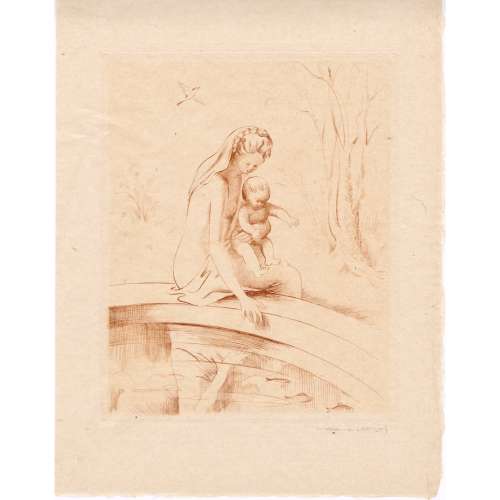 Set of 10 etchings (9 in passe-partout) printed in sanguine on the mother of pearl paper (japon nacre) from the album of 12 prints titled “Jeunesse”, presented by Gérard D'Houville (pen name of Marie de Régnier, née de Heredia) and published by La Tradition in 1945. It was a limited edition of 532 copies, some coloured on Arches paper and some as these set. Plates signed by the artist in pencil below the plate mark. The album cover is missing. Title-page: JEUNESSE | 12 EAUX-FORTES ORIGINALES | DE | MARIANNE CLOUZOT | PRÉSENTÉES | PAR | GÉRARD D'HOUVILLE | {publisher’s device} | LA TRADITION | 1945 || Dimensions: mat 330 x 255 mm; window 225 x 180 mm; sheet 280 x 220 mm; plate 220 x 170 mm. Contributors: Marianne Clouzot (French, 1908 – 2007) – artist Marie de Régnier [Marie de Heredia, Gérard d'Houville] (French, 1875 – 1963) – editor
Set of 10 etchings (9 in passe-partout) printed in sanguine on the mother of pearl paper (japon nacre) from the album of 12 prints titled “Jeunesse”, presented by Gérard D'Houville (pen name of Marie de Régnier, née de Heredia) and published by La Tradition in 1945. It was a limited edition of 532 copies, some coloured on Arches paper and some as these set. Plates signed by the artist in pencil below the plate mark. The album cover is missing. Title-page: JEUNESSE | 12 EAUX-FORTES ORIGINALES | DE | MARIANNE CLOUZOT | PRÉSENTÉES | PAR | GÉRARD D'HOUVILLE | {publisher’s device} | LA TRADITION | 1945 || Dimensions: mat 330 x 255 mm; window 225 x 180 mm; sheet 280 x 220 mm; plate 220 x 170 mm. Contributors: Marianne Clouzot (French, 1908 – 2007) – artist Marie de Régnier [Marie de Heredia, Gérard d'Houville] (French, 1875 – 1963) – editor -
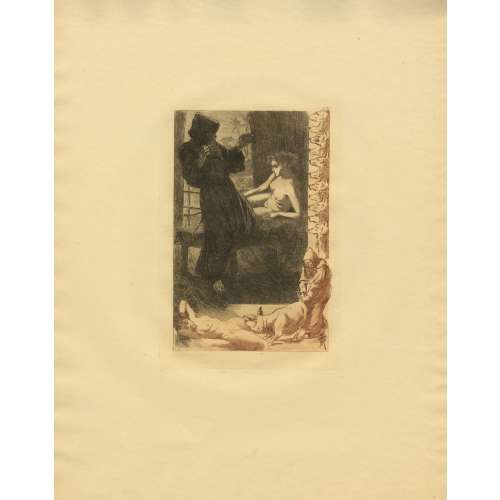 Set of 21 etchings by Martin van Maele for the English edition of ‘Thais’ by Anatole France published in London by Charles Carrington in 1901. Printed on vowe paper without a watermark in two colours with the black image and sepia historiated border. All etchings are inscribed with the artist's monogram; one of the etchings bears inscriptions ORGUEIL, LUXURE, DOUTE (mirror image). Dimensions: sheet: 317 x 250 mm; plate: 170 x 115 mm; image: 155 x 100 mm. Catalogue raisonné: S. A. Perry: № 64. Per Perry, the edition was printed in 500 copies on 'handmade paper watermarked 'Van Gelder'. Contributor: Martin van Maële [Martin, Maurice François Alfred] (French, 1863 – 1926)
Set of 21 etchings by Martin van Maele for the English edition of ‘Thais’ by Anatole France published in London by Charles Carrington in 1901. Printed on vowe paper without a watermark in two colours with the black image and sepia historiated border. All etchings are inscribed with the artist's monogram; one of the etchings bears inscriptions ORGUEIL, LUXURE, DOUTE (mirror image). Dimensions: sheet: 317 x 250 mm; plate: 170 x 115 mm; image: 155 x 100 mm. Catalogue raisonné: S. A. Perry: № 64. Per Perry, the edition was printed in 500 copies on 'handmade paper watermarked 'Van Gelder'. Contributor: Martin van Maële [Martin, Maurice François Alfred] (French, 1863 – 1926)


